Pubblicazioni recenti in evidenza
Graphene Acetic Acid-Based Hybrid Supercapacitor and Liquid-Gated Transistor
Rafael C. Hensel, Biagio Di Vizio, Verónica Montes-García, Jijin Yang, Georgian G. Ilie, Francesco Sedona, Mauro Sambi, Paolo Samorì, Andrea Cester, Stefano Agnoli, Stefano Casalini*
Advanced Electronic Materials
IF = 7,633
Supercapacitors and transistors are two key devices for future electronics that must combine portability, high performance, easy scalability, etc. Graphene-related materials (GRMs) are frequently chosen as active materials for these applications given their unique physical properties that are tunable via chemical functionalization. Up to date, among GRMs, only reduced graphene oxide (rGO) showed sufficient versatility and processability in mild media, rendering it suitable for integration in these two types of devices. Here, a sound alternative to rGO is provided, namely graphene acetic acid (GAA), whose physico-chemical features offer specific advantages. In particular, the use of a GAA-based cathode in a zinc hybrid supercapacitor (Zn-HSC) delivers state-of-the-art gravimetric capacitance of ≈400 F g−1 at a current density of 0.05 A g−1. Conversely, GAA-based LGT, supported onto Si/SiO2, shows an ambipolar behavior in 0.1 m NaCl, featuring a clear p-doping quantified by Dirac voltage higher than 100 mV. Such a device is successfully implemented in paper fluidics, thereby demonstrating the feasibility of real-time monitoring.
DOI: 10.1002/aelm.202300685
Reduced Graphene Oxide Electrolyte-Gated Transistor Immunosensor with Highly Selective Multiparametric Detection of Anti-Drug Antibodies
Matteo Sensi, Rafael Furlan de Oliveira, Marcello Berto, Marina Palmieri, Emilio Ruini, Pietro A. Livio, Andrea Conti, Marcello Pinti, Carlo Salvarani, Andrea Cossarizza, Joan M. Cabot, Jordi Ricart, Stefano Casalini, María Begoña González-García, Pablo Fanjul-Bolado, Carlo Augusto Bortolotti, Paolo Samorì, Fabio Biscarini
Advanced Materials
IF = 32,086
The advent of immunotherapies with biological drugs has revolutionized the treatment of cancers and auto-immune diseases. However, in some patients the production of anti-drug antibodies (ADAs) hampers the drug efficacy. The concentration of ADAs is typically in the range of 1-10 pM, hence their immunodetection is challenging. We focus here on ADAs towards Infliximab (IFX), a drug used to treat rheumatoid arthritis and other auto-immune diseases. We report an ambipolar electrolyte-gated transistor (EGT) immunosensor based on reduced graphene oxide (rGO) channel and IFX bound to the gate electrode as the specific probe. The rGO-EGTs are easy to fabricate, exhibit low voltage operations (≤ 0.3 V), a robust response within 15 min, and ultra-high sensitivity (10 aM limit of detection). We propose a multiparametric analysis of the whole rGO-EGT transfer curves based on the type-I generalized extreme value distribution. We demonstrate that it allows us to selectively quantify ADAs also in the co-presence of its antagonist tumour necrosis factor alpha (TNF-□), the natural circulating target of IFX.
DOI: 10.1002/adma.202211352
Signal amplification properties of Electrolyte-Gated Organic Field-Effect Transistors
Nicolò Lago, Sara Ruiz Molina, Marta Mas Torrent, Stefano Casalini and Andrea Cester
2023 IEEE International Workshop on Metrology for Industry 4.0 & IoT (MetroInd4.0&IoT)
Electrolyte-gated organic field-effect transistors (EGOFETs) are key enabling elements for the development of bio-electronic devices, therefore it is imperative to increase the knowledge on how EGOFETs work, not only in stationary conditions but also in the time and frequency domain. In this framework, the EGOFET small-signal circuit is presented and the recording of action potentials (APs) is simulated by analyzing EGOFETs as trans-conductance amplifiers as well as voltage amplifiers. It is shown that when operating as a transconductance amplifier, EGOFETs ideally allow to well preserve the shape of the recorded AP but they amplify high-frequency noise thus heavily worsening the signal-to-noise ratio (SNR). Whereas, when implemented in a voltage amplifier, EGOFETs allow a substantial SNR improvement, but introduce some distortion in the recorded signal.
DOI: 10.1109/MetroInd4.0IoT57462.2023.10180138
Cu-modified electrolyte-gated transistors based on reduced graphene oxide
Rafael Cintra Hensel, Nicola Comisso, Marco Musiani, Francesco Sedona, Mauro Sambi, Andrea Cester, Nicolò Lago, Stefano Casalini
Journal of Materials Chemistry C
IF = 6,4
Electrolyte-gated transistors (EGTs) have attracted extensive attention due to their versatility and excellent performance in different fields of electronics. Here, we report on coplanar EGTs based on reduced graphene oxide (rGO), whose gates (flexible Au micro-electrodes) were modified by electrodeposition of either compact or porous Cu coatings (Cu-modified EGTs). The Cu coatings yielded a dramatic change in the minimum gate voltage spanning from 50 mV to 300 mV, which allowed extremely versatile tuning of the device signal. Furthermore, steady measurements led us to carry out prolonged measurements (42 hours) under a constant bias in NaCl 0.1 M solution which was driven onto the EGTs by using homemade paper fluidics. Transient characterization studies pointed out a potentiometric sensitivity of around 1–3 mV with a signal-to-noise ratio (SNR) close to 5–10 for both electron and hole transport regimes. Since the response time of our Cu-modified EGTs was as low as 80 ms, we succeeded in monitoring emulated action potential (eAP) featuring a characteristic frequency
equal to 0.1 Hz.
DOI: 10.1039/d3tc00596h
Understanding Oxygen Release from Nanoporous Perovskite Oxides and Its Effect on the Catalytic Oxidation of CH4 and CO
E. Poffe, H. Kaper, B. Ehrhardt, L. Gigli, D. Aubert, L. Nodari, S. Gross and S. Mascotto
Article in press in ACS Applied Materials & Interfaces
I. F.: 8.758 (2019)
The design of nanoporous perovskite oxides is considered an efficient strategy to develop performing, sustainable catalysts for the conversion of methane. The dependency of nanoporosity on the oxygen defect chemistry and the catalytic activity of perovskite oxides towards CH4 and CO oxidation was here studied. A novel colloidal synthesis route for nanoporous, hightemperature stable SrTi0.65Fe0.35O3-δ with specific surface area (SSA) ranging from 45 to 80 m2 /g and pores from 10 to 100 nm was developed. High-temperature investigations by in situ synchrotron XRD and TG-MS combined with H2-TPR and Mössbauer spectroscopy showed that the porosity improved the release of surface oxygen and the oxygen diffusion, whereas the release of lattice oxygen depended more on the state of the iron species and strain effects in the materials. Regarding catalysis, light-off tests showed that low-temperature CO oxidation significantly benefitted from the enhancement of the SSA, whereas high-temperature CH4 oxidation is influenced more from the dioxygen release. During isothermal long-term catalysis tests however the continuous oxygen release from large SSA materials promoted both CO and CH4 conversion. Hence, if SSA maximization turned out to efficiently improve low-temperature and long-term catalysis applications, the role of both reducible metal center concentration and crystal structure cannot be completely ignored, as they also contribute to the perovskite oxygen release properties.
Opportunities from doping of non-critical metal oxides in last generation light-conversion devices
Teresa Gatti, Francesco Lamberti, Raffaello Mazzaro, Ilka Kriegel, Derck Schlettwein, Francesco Enrichi, Nicolò Lago, Eleonora Di Maria, Gaudenzio Meneghesso, Alberto Vomiero, Silvia Gross
Adv. Energy Mater., Just Accepted Manuscript
DOI: 10.1002/aenm.202101041
I. F.: 25.2
The need to develop sustainable energy solutions is an urgency for our societies, with the additional stringent requirement to limit dependence on critical raw materials and to implement a virtuous circular economy model. In this framework, it is essential to identify new avenues for light-conversion into clean energy and fuels exploiting largely available materials and green production methods. Metal oxide semiconductors (MOSs) emerge among other species for their remarkable environmental, thermal and chemical stability, wide chemical tunability, and interesting optoelectronic properties. MOSs are often key constituents in next generation energy devices, mainly with the role of charge selective layers. Their use as light harvesters is hitherto rather limited, but progressively emerging. One of the key strategies to boost and tailor their properties resorts to doping, that can improve charge mobility, light absorption and can tune band structures to maximize charge carrier separation at heterojunctions. In this perspective, we identify and critically compare effective methods to dope MOSs and to exploit the deriving benefits in relation to performance enhancement in different types of light-conversion devices. We focus specifically on the best opportunities coming from the use of non-critical raw materials, so as to contribute in defining an economically feasible roadmap for light energy conversion technologies based on these highly stable and largely available compounds.
Enabling circular economy: the overlooked role of inorganic materials chemistry
Gabriella Salviulo, Maria Cristina Lavagnolo, Manuele Dabalà, Enrico Bernardo, Antonino Polimeno, Mauro Sambi, Franco Bonollo and Silvia Gross
Invited Essay, Chemistry A European Journal, 2021, 27, 1-21
DOI: 10.1002/chem.202002844
Circular economy, acknowledged as “an opportunity to rethink our economic future”, is considered a new chance to build a more sustainable world from both the social and the economic point of views. Europe and European member states are resolutely moving toward a circular paradigm in goods design and production, a scenario which requires a robust technical and scientific background, where chemistry is expected to play a major role. The pivotal role of chemistry in supporting and fostering this implementation has been exemplarily outlined in three very recent papers as well as in technical reports focusing on the contribution of chemistry to consolidate the assets of the chemical industry towards the circular economy model. In this Essay paper, by adopting a truly interdisciplinary approach, encompassing expertise in inorganic materials chemistry, modelling, materials engineering, circular waste management, metallurgy, mineralogy, we outline the possible contribution of inorganic chemistry towards a smooth transition to circularity in inorganic materials design and production, to enable them to enter into the circular loop. A further aim of this contribution is also to contextualise these efforts within a coherent and holistic framework provided by the policies of the European Commission, entailing also sizable regulatory initiatives, and by a worldwide leaning toward a more sustainable development.
Large cation engineering in two-dimensional silver-bismuth bromide double perovskites
Fabian Schmitz, Jonas Horn, Nicola Dengo, Alexander E. Sedykh, Jonathan Becker, Elena Maiworm, Péter Bélteky, Ákos Kukovecz, Silvia Gross, Francesco Lamberti, Klaus Müller-Buschbaum, Derck Schlettwein, Daniele Meggiolaro, Marcello Righetto, Teresa Gatti
Chem. Mater.., Just Accepted Manuscript
https://doi.org/10.1021/acs.chemmater.1c01182
I. F.: 9.6
Double perovskites are promising candidates for less toxic and highly stable metal halide perovskites, but their optoelectronic performances still lag behind those of the lead halide counterpart, due to the indirect nature of the bandgap and the strong electron-phonon coupling. Reducing the dimensionality of Cs2AgBiBr6 down to a 2D layered form is strategic in order to tune the band gap from indirect to direct and provides new insights into the structure-property relationships of double perovskites. Herein, we report on a series of monolayer 2D hybrid double perovskites of formula (RA)4AgBiBr8, where RA represents different primary ammonium large cations with alkyl- and aryl-based functionalities. An in-depth experimental characterization of structure, film morphology and optical properties of these perovskites is carried out. Interestingly, the variation of the ammonium cation and the inter-planar distance between adjacent inorganic monolayers has peculiar effects on the film-forming ability and light emission properties of the perovskites. Experiments have been combined with DFT calculations in order to understand the possible origin of the different emissive features. Our study provides a toolbox for future rational developments of 2D double perovskites, with the aim of narrowing the gap with lead halide perovskite optoelectronic properties.
Hybridization of Molecular and Graphene Materials for CO2 Photocatalytic Reduction with Selectivity Control
Bing Ma, Matias Blanco, Laura Calvillo, Lingijing Chen, Gui Chen, Tai-Chu Lau, Goran Drazic, Julien Bonin, Marc Robert and Gaetano Granozzi
J. Am. Che. Soc. 2021
IF: 14.612
DOI: 10.1021/jacs.1c02250
In the quest for designing efficient and stable photocatalytic materials for CO2 reduction, hybridizing a selective noble-metal-free molecular catalyst and carbon-based light-absorbing materials has recently emerged as a fruitful approach. In this work, we report about Co quaterpyridine complexes covalently linked to graphene surfaces functionalized by carboxylic acid groups. The nanostructured materials were characterized by X-ray photoemission spectroscopy, X-ray absorption spectroscopy, IR and Raman spectroscopies, and high-resolution transmission electron microscopy and proved to be highly active in the visible-light-driven CO2 catalytic conversion in acetonitrile solutions. Exceptional stabilities (over 200 h of irradiation) were obtained without compromising the selective conversion of CO2 to products (>97%). Most importantly, complete selectivity control could be obtained upon adjusting the experimental conditions: production of CO as the only product was achieved when using a weak acid (phenol or trifluoroethanol) as a co-substrate, while formate was exclusively obtained in solutions of mixed acetonitrile and triethanolamine.
Selective and scaled-up continuous flow synthesis of manganese oxide nanocatalysts for single electron transfer reactions
Dario Mosconi, Matías Blanco, JiaJia Ran, Marco Sturaro, Marco Bersani, Gaetano Granozzi
Chem. Eng. J. 2021
IF: 10.652
DOI: 10.1016/j.cej.2021.129063
The application of high-quality nanomaterials in industrial products and processes is somewhat hindered by their actual market availability at a large scale, mostly due to preparation methods which can be hardly scalable for cost, reproducibility, sustainability or complexity issues. Herein, the application of the Continuous Flow Hydrothermal Synthesis (CFHS) is presented to prepare various nano Mn oxides in supercritical water with common and low-cost precursors and additives, yielding an outstanding production rate of 1 Kg day-1. Since Mn oxidation state spans from MnII to MnVII, the implemented process generates, with exquisite selectivity and consistency, nanosized MnO, α-MnO2, β-MnO2, λ-MnO2, Mn2O3, Mn3O4 and LiMn2O4 oxides with reproducible characteristics of the obtained phase under controlled synthetic conditions. As a case study, all our MnOx nanomaterials were tested as catalyst precursors in the Single Electron Transfer (SET) oxidation of olefins with 1,3-dicarbonyl compounds, obtaining recyclable active materials whose respective activity depends on the particular oxide structure, therefore proving the importance of phase selectivity in the final application.
Multimodal hybrid 2D networks via the thiol-epoxide reaction on 1T/2H MoS2 polytypes
Giulia Tuci, Andrea Rossin, Cuong Pham-Huu, Dario Mosconi, Lapo Luconi, Stefano Agnoli, Gaetano Granozzi and Giuliano Giambastiani
Mater. Chem. Front., 2021
IF: 6.788
DOI: 10.1039/d1qm00003a
Searching for new protocols aimed at the surface functionalization of TMDCs is the password for filling the gap between reactivity and versatility of 2D carbon-based networks and their inorganic counterparts.
This contribution describes a straightforward but effective approach to the chemical decoration of chemically exfoliated MoS2 nanosheets with -hydroxyl organic pendant arms. The adopted strategy is based on the thiol-epoxide ‘‘click’’ reaction and generates functional hybrids with a loading of dangling organic groups directly proportional to the epoxide electrophilic character. Most importantly, this grafted methodology occurs for the first time on both phases (1T and 2H) of the model chalcogenide and provides functional samples suitable for an additional functionalization step-forward (post-derivatization).
Light-mediated control of activity in a photosensitive foldamer that mimics an esterase
Matteo Pollastrini, Giulia Marafon, Jonathan Clayden and Alessandro Moretto
Chemical Communications
IF: 6.050
https://doi.org/10.1039/D0CC08309G (2021)
We report a catalytic foldamer in which a fumaramide chromophore links a Ser residue to a helical domain that contains within its sequence the residues His and Asp. Photoisomerization of the fumaramide chromophore (with E geometry) to the corresponding maleamide (with Z geometry) brings together a ‘catalytic triad’ of Ser, His, and Asp, triggering esterase activity that is absent in the fumaramide isomer. The fumaramide/maleamide linker thus acts as a light-sensitive switchable cofactor for activation of catalytic activity in short foldamers.
Photoresponsive Prion-Mimic Foldamer to Induce Controlled Protein Aggregation
Giulia Marafon, Marco Crisma, Anna Masato, Nicoletta Plotegher,Luigi Bubacco, Alessandro Moretto
12 November 2020 https://doi.org/10.1002/anie.202012995
Angewandte Chemie International Edition
Impact Factor 12.95
Proteins reconfigure their 3D-structure, and consequently their function, under the control of specific molecular interactions that sense, process and transmit information from the surrounding environment. When this fundamental process is hampered, many pathologies occur as in the case of protein misfolding diseases. In this work, we follow the early steps of α-synuclein (aS) aggregation, a process associated with Parkinson’s disease etiopathogenesis, that is promptly promoted by a light-mediated binding between the protein and a photoactive foldamer. The latter can switch between two conformations, one of which generates supramolecular fibrillar seeds that act as molecular templates able to induce a fast β-sheet transition for aS monomers that successively undergo fibrillar polymerization. The proposed method represents a powerful tool to study protein aggregation relevant to misfolding diseases in a controlled and inducible system.
Harnessing Selectivity and Sensitivity in Ion Sensing via Supramolecular Recognition: A 3D Hybrid Gold Nanoparticle Network Chemiresistor
Verónica Montes-García, Rafael Furlan de Oliveira, Ye Wang, Andrey Berezin, Pablo Fanjul-Bolado, María Begoña González García, Thomas M. Hermans, Davide Bonifazi, Stefano Casalini, and Paolo Samorì
Advanced Functional Materials
Impact Factor of the Journal:
IF=16.836
DOI: 10.1002/adfm.202008554
The monitoring of K+ in saliva, blood, urine, or sweat represents a future powerful alternative diagnostic tool to prevent various diseases. However, several K+ sensors are unable to meet the requirements for the development of point-of-care (POC) sensors. To tackle this grand-challenge, the fabrication of chemiresistors (CRs) based on 3D networks of Au nanoparticles covalently bridged by ad-hoc supramolecular receptors for K+, namely dithiomethylene dibenzo-18-crown-6 ether is reported here. A multi-technique characterization allows optimizing a new protocol for fabricating high-performing CRs for real-time monitoring of K+ in complex aqueous environments. The sensor shows exceptional figures of merit: i) linear sensitivity in the 10–3 to 10–6 m concentration range; ii) high selectivity to K+ in presence of interfering cations (Na+, Ca2+, and Mg2+); iii) high shelf-life stability (>45 days); iv) reversibility of K+ binding and
release; v) successful device integration into microfluidic systems for real-time monitoring; vi) fast response and recovery times (<18 s), and v) K+ detection in artificial saliva. All these characteristics make the supramolecular CRs a potential tool for future applications as POC devices, especially for health monitoring where the determination of K+ in saliva is pivotal for the early diagnosis of diseases.
New insights in the slow ligand exchange reaction between Cr(III)-EDTA and Fe(III), and direct analysis of free and complexed EDTA in tannery wastewaters by liquid chromatography - Tandem mass spectrometry
Marco Roverso, Valerio Di Marco, Gabriella Favaro, Iole Maria Di Gangi, Denis Badocco, Mirco Zerlottin, Daniele Refosco, Andrea Tapparo, Sara Bogialli, Paolo Pastore.
Rivista: Chemosphere 2021 Volume 264 (1), 128487, IF 5.778
DOI: https://doi.org/10.1016/j.chemosphere.2020.128487
Abstract: EDTA and soluble Cr(III) are usually both present in wastewaters coming from treatment plants handling tannery effluents. A well-established method to determine EDTA is based on the conversion of free and complexed EDTA into its Fe(III) complex. This procedure gives inconsistent data when Cr(III)-EDTA is present. This fact was here demonstrated by studying the kinetics of the exchange reaction between Fe(III) and Cr(III)-EDTA at 90 °C and various pH values, from acidic to neutral. The reaction is very slow (several weeks); the slow kinetics of conversion of Cr(III)-EDTA to Fe(III)-EDTA is even more accentuated at room temperature and the low concentrations of reactants in wastewaters. The presence of EDTA complexes of Fe(III) and Cr(III) was demonstrated in industrial effluents and wastewaters by developing a selective method based on liquid chromatography-tandem mass spectrometry (LC-MS/MS), which was able to detect free and complexed EDTA at concentration levels <1 μM. A systematic underestimation of the EDTA expressed as Fe(III) complex was demonstrated in samples containing Cr(III)-EDTA. Cr(III)-EDTA was identified for the first time as a component of wastewater samples at a concentration level of about 2 μM and turned out to be an inert species that significantly contributes to the final soluble Cr amount. This study gives new insights into the inertness of Cr(III) toward metal exchange equilibria of EDTA complexes, resolves a bias in the analysis of total EDTA in samples containing Cr(III)-EDTA, allowing the direct determination of free and complexed EDTA by LC-MS.
Elucidation of the Intersystem Crossing Mechanism in a Helical BODIPY for Low-Dose Photodynamic Therapy
Zhijia Wang, Ling Huang, Yuxin Yan, Ahmed M. El-Zohry, Antonio Toffoletti, Jianzhang Zhao, Antonio Barbon, Bernhard Dick, Omar F. Mohammed, and Gang Han
Angew. Chem. Int. Ed. 2020, 59, 16114–16121
Impact Factor of 12.959 (2019)
https://doi.org/10.1002/anie.202005269
Intersystem crossing (ISC) of triplet photosensitizers is a vital process for fundamental photochemistry and photodynamic therapy (PDT). However, the currently effective long wavelength operating photosensitizers have to rely on heavy atoms to enhance ISC. Unfortunately, the heavy atoms, besides its toxicity, can also cause significant reduction in the triplet excited state lifetime of the photosensitizers, which are fundamentally detrimental to further applications. To overcome this challenge, we report on the discovery of the co-existence of superior intersystem crossing and the long triplet excited lifetime in a heavy atom-free Bodipy helicene molecule. Via comprehensive theoretical computation and advanced time-resolved electron paramagnetic resonance spectroscopy, this unique property is evidently confirmed to be directly associated with its unusual twisted molecular structure and reduced symmetry. We showed that such a twisted Bodipy helicene molecule shows exceptionally intense long wavelength absorption (abs coeff. = 1.76 ´ 105 M-1cm-1 at 630 nm), superior triplet quantum yield (yield = 52%) and a super long-lived triplet state (lifetime = 492 us), leading to unprecedented performance as a triplet photosensitizer for PDT. Moreover, nanoparticles constructed with such helical Bodipy triplet photosensitizer were found to achieve surprisingly efficient PDT mediated antitumor immunity amplification with ultra-low dose (0.25 ug/kg body weight), which is found to be about hundreds of time lower than the existing PDT reagents. Our study paves the way to design the next generation of triplet photosensitizers, which should be significant on both fronts: fundamental science and clinical applications.
Microfluidic crystallization of surfactant-free doped zinc sulfide nanoparticles for optical bioimaging applications
Francesca Tajoli, Nicola Dengo, Maddalena Mognato, Paolo Dolcet, Giacomo Lucchini, Andrea Faresin, Jan-Dierk Grunwaldt, Xiaohui Huang, Denis Badocco, Michele Maggini, Christian Kübel, Adolfo Speghini, Tommaso Carofiglio,* Silvia Gross*
ACS Applied Materials & Interfaces
IF= 8.758 (2019)
The room temperature, controlled crystallization of monodispersed ZnS nanoparticles (average size of 5 nm) doped with luminescent ions (such as Mn2+, Eu3+, Sm3+, Nd3+, Yb3+) was achieved via a microfluidic approach. The preparation did not require any stabilizing ligands or surfactants, minimizing potential sources of impurities. The synthesized nanomaterials were characterized from a structural (XRD, XAS at lanthanide L3 edges), morphological (TEM) and compositional (XPS, ICP-MS) perspective, giving complementary information on the materials’ features. In view of potential applications in the field of optical bioimaging, the optical emission properties of the doped nanoparticles were assessed, and samples showed strong luminescent properties, meanwhile being less affected by self-quenching mechanisms. Furthermore, in vitro cytotoxicity experiments were conducted, showing no negative effects and evidencing the appeal of the synthesized materials for potential applications in the field of optical bioimaging.
Label-free immunodetection of α-synuclein by using a microfluidics coplanar electrolyte-gated organic field-effect transistor
Simona Ricci, Stefano Casalini, Vitaliy Parkula, Meenu Selvaraj, Gulseren Deniz Saygin, Pierpaolo Greco, Fabio Biscarini, Marta Mas-Torrent
Biosensors and Bioelectronics
IF=10.257
The aggregation of α-synuclein is a critical event in the pathogenesis of neurological diseases, such as Parkinson or Alzheimer. Here, we present a label-free sensor based on an Electrolyte-Gated Organic Field-Effect Transistor (EGOFET) integrated with microfluidics that allows us to detect amounts of α-synuclein in the range from 0.25 pM to 25 nM. The lower limit of detection (LOD) measures the potential of our integrated device as a tool for prognostics and diagnostics. In our device, the gate electrode is the effective sensing element as it is functionalized with anti-(α-synuclein) antibodies using a dual strategy: i) an amino-terminated self-assembled monolayer activated by glutaraldehyde, and ii) the His-tagged recombinant protein G. In both approaches, comparable sensitivity values were achieved, featuring very low LOD values at the sub-pM level. The microfluidics engineering is central to achieve a controlled functionalization of the gate electrode and avoid contamination or physisorption on the organic semiconductor. The demonstrated sensing architecture, being a disposable stand-alone chip, can be operated as a point-of-care test, but also it might represent a promising label-free tool to explore in-vitro protein aggregation that takes place during the progression of neurodegenerative illnesses.
Insights into the mechanism of coreactant electrochemiluminescence facilitating enhanced bioanalytical performance
Alessandra Zanut, Andrea Fiorani, Sofia Canola, Toshiro Saito, Nicole Ziebart, Stefania Rapino, Sara Rebeccani, Antonio Barbon, Takashi Irie, Hans-Peter Josel, Fabrizia Negri, Massimo Marcaccio, Michaela Windfuhr, Kyoko Imai, Giovanni Valenti & Francesco Paolucci
Nature Communications volume 11, Article number: 2668 (2020)
https://doi.org/10.1038/s41467-020-16476-2
Electrochemiluminescence (ECL) is a powerful transduction technique with a leading role in the biosensing field due to its high sensitivity and low background signal. Although the intrinsic analytical strength of ECL depends critically on the overall efficiency of the mechanisms of its generation, studies aimed at enhancing the ECL signal have mostly focused on the investigation of materials, either luminophores or coreactants, while fundamental mechanistic studies are relatively scarce. Here, we discover an unexpected but highly efficient mechanistic path for ECL generation close to the electrode surface (signal enhancement, 128%) using an innovative combination of ECL imaging techniques and electrochemical mapping of radical generation. Our findings, which are also supported by quantum chemical calculations and spin trapping methods, led to the identification of a family of alternative branched amine coreactants, which raises the analytical strength of ECL well beyond that of present state-of-the-art immunoassays, thus creating potential ECL applications in ultrasensitive bioanalysis.
Establishing Reactivity Descriptors for Platinum Group Metal (PGM)-free Fe-N-C Catalysts for PEM Fuel Cells
Mathias Primbs, Yanyan Sun, Aaron Roy, Daniel Malko, Asad Mehmood, Moulay-Tahar Sougrati, Pierre-Yves Blanchard, Gaetano Granozzi, Tomasz Kosmala, Giorgia Daniel, Plamen Atanassov, Jonathan Sharman, Christian Durante, Anthony Kucernak, Deborah Jones, Frédéric Jaouen, Peter Strasser
Energy and Environmental Science., 2020, (IF: 33.250)
DOI: 10.1039/D0EE01013H
We report a comprehensive analysis of the catalytic oxygen reduction reaction (ORR) reactivity of four of today’s most active benchmark platinum group metal-free (PGM-free) iron/nitrogen doped carbon electrocatalysts (Fe-N-Cs). Our analysis reaches far beyond previous such attempts in linking kinetic performance metrics, such as electrocatalytic mass-based and surface area-based catalytic activity with previously elusive kinetic metrics such as the active metal site density (SD) and the catalytic turnover frequency (TOF). Kinetic ORR activities, SD and TOF values were evaluated using in-situ electrochemical NO2- reduction as well as an ex-situ gaseous CO cryo chemisorption. Experimental ex-situ and in-situ Fe surface site densities displayed remarkable quantitative congruence. Plots of SD versus TOF (“reactivity maps”) are utilized as new analytical tools to deconvolute ORR reactivities and thus enabling rational catalyst developments. A microporous catalyst showed large SD values paired with low TOF, while mesoporous catalysts displayed the opposite. Trends in Fe surface site density were linked to molecular nitrogen and Fe moieties (D1 and D2 from 57Fe Mössbauer spectroscopy), from which pore locations of catalytically active D1 and D2 sites were established. This cross-laboratory analysis, its employed experimental practices and analytical methodologies are expected to serve as a widely accepted reference for future, knowledge-based research into improved PGM-free fuel cell cathode catalysts.
Copper Vanadate Nanobelts as Anodes for Photoelectrochemical Water Splitting: Influence of CoOx Overlayers on Functional Performances
Leonardo Girardi, Gian Andrea Rizzi, Lorenzo Bigiani, Davide Barreca, Chiara Maccato, Carla Marega and Gaetano Granozzi
ACS Appl. Mater. Interfaces, Just Accepted Manuscript
(IF: 8.456)
DOI: 10.1021/acsami.0c0691
The design and development of environmentally friendly and robust anodes for photoelectrochemical (PEC) water splitting plays a critical role for the efficient conversion of radiant energy into hydrogen fuel. In this regard, quasi 1D copper vanadates (CuV2O6) were grown on conductive substrates by a hydrothermal procedure and processed for use as anodes in PEC cells, with particular attention on the role exerted by cobalt oxide (CoOx) overlayers deposited by radio frequency (RF)-Sputtering. The target materials were characterized in detail by a multi-technique approach, with the aim at elucidating the interplay between their structure, composition, morphology and the resulting activity as photoanodes. Functional tests were performed by standard electrochemical techniques like linear sweep voltammetry, impedance spectroscopy and by the less conventional intensity modulated photocurrent spectroscopy, yielding an important insight into the material PEC properties. The obtained results highlight that, despite the supposedly favourable band alignment between CuV2O6 and Co3O4 did not yield a net current density increase, cobalt oxide-functionalized anodesafforded a remarkable durability enhancement, an important pre-requisite for their eventual real-world applications. The concurrent phenomena accounting for the observed behavior are presented and discussed in relation to material physico-chemical properties.
Ligand-free ZnS nanoparticles: as easy and green as it gets
Nicola Dengo, Andrea Faresin, Tommaso Carofiglio, Michele Maggini*, Longfei Wu, Jan P. Hofmann, Emiel J. M. Hensen, Paolo Dolcet, and Silvia Gross*
Communication
ChemComm, Just Accepted Manuscript
I. F.: 6.164
The controlled nucleation and crystallization of small pure sphalerite ZnS nanoparticles was achieved under batch and continuous flow conditions at low temperature, in water and without the use of any stabilizing ligand. The obtained nanoparticles displayed a narrow size distribution and high specific surface area. Moreover, the synthesis was suitable to directly obtain stable water-based suspensions and the products were found to be active photocatalysts for the hydrogen evolution reaction.
Stable, Active and Methanol Tolerant PGM-free Surface in Acidic Medium: Electron Tunneling at Play in Pt/FeNC Hybrid Catalysts for Direct Methanol Fuel Cell Cathode
Tomasz Kosmala, Nicolas Bibent, Moulay Tahar Sougrati, Goran Dražić, Stefano Agnoli, Frédéric Jaouen and Gaetano Granozzi
ACS Catalysis., 2020, (IF: 12.221)
doi.org/10.1021/acscatal.0c01288
PGM-free catalysts have high initial activity for O2 reduction reaction, but suffer from low stability in acid medium in PEMFC and DMFC. Here, we shed light on the atomic-scale structure of hybrid Pt/FeNC catalysts (1-2 wt% of Pt), revealing by STEM and EDXS the presence of Pt@FeOx particles. The absence of exposed Pt on the surface is confirmed by the suppression of methanol oxidation reaction and CO stripping experiments. The promising application of such Pt/FeNC catalysts, comprising FeNx sites and Pt@FeOx particles, is demonstrated at the cathode of DMFC. To gain fundamental understanding on the stability in acid medium and on the intrinsic ORR activity of Pt@FeOx, we constructed model surfaces by depositing FeOx films with controlled thickness (from 1.0 to 6.4 nm), fully covering the Pt(111) surface, which resulted stable in acid medium in the potential range 0.45 – 1.05 V vs. RHE. The specific ORR activity of Fe2O3/Pt(111) increases exponentially with decreasing overlayer thickness, which is explained by the tunneling of Pt electrons through Fe2O3. This special phenomenon sheds light onto recently reported excellent durability of Pt/FeNC composites in PEMFC and identify a promising core@shell strategy leading to stable PGM-free surfaces in acid medium, and tolerant to methanol.
Boron oxynitride two-colours fluorescent dots and their incorporation in a hybrid organic-inorganic film
Junkai Ren, Luca Malfatti, Stefano Enzo, Carlo Maria Carbonaro, Laura Calvillo, Gaetano Granozzi, Plinio Innocenzi
Journal of Colloid and Interface Science 560 (2020) 398–406, (IF: 6.361)
doi.org/10.1016/j.jcis.2019.10.020
Bottom-up synthesis of fluorescent boron-nitride based dots is a challenging task because an accurate design of the structure-properties relationship is, in general, difficult to achieve. Incorporation of the dots into a solid-state matrix is also another important target to develop light-emitting devices.
Two-colour fluorescent boron oxynitride nanodots have been obtained by a bottom-up synthesis route and incorporated into a hybrid organic-inorganic film. A combination of different analytical techniques such as XPS, XRD, TEM, UV–Vis, TGA-DTA and fluorescence has been used to characterise the structure, composition and properties of the boron oxynitride dots. The presence of defects in the boron oxynitride structure is the source of the two-colour fluorescence. The BN dots thermal stability is limited to around 100 °C; higher temperatures induce condensation of the structure, which leads to a lower emission. Upon incorporation into a hybrid organic-inorganic film deposited by spin-coating, the boron oxynitride dots maintain their fluorescence and have shown to be highly compatible with the sol-gel chemistry.
Tuning on and off chemical- and photo-activity of exfoliated MoSe2 nanosheets through morphologically selective “soft” covalent functionalization with porphyrins
Matias Blanco, Marco Lunardon, M. Bortoli, Dario Mosconi, Leonardo Girardi, Laura Orian, Stefano Agnoli and Gaetano Granozzi
J. Mat. Chem. A 2020, (IF: 10.733)
DOI: 10.1039/D0TA03302B
The covalent functionalization of 2D transition metal dichalcogenides (TMDCs) with organic molecules exploiting the thiol conjugation approach is still a very controversial topic. We have synthesized thiolated tetraphenyl porphyrins, with and without hydroxyl groups in the phenyl substituents, which have been covalently attached to chemically exfoliated MoSe2 (ce-MoSe2) nanosheets. XPS and FTIR have revealed the formation of sulfo-selenide bridges, specifically on the edges of the ce-MoSe2, as confirmed by first principle calculations. The TMDCs’ electrocatalytic activity in the hydrogen evolution reaction (HER) has been investigated after conjugation with the organic molecules. The HER activity is suppressed or enhanced according to the presence of mildly acid hydroxyls groups in the attached molecules, since they provide a local proton relay boosting the production of H2, especially in mildly acidic conditions (pH=4.3). Moreover, the well-known light-harvesting properties of porphyrins have been exploited to improve significantly the light-assisted HER activity. Due to the formation of a type II heterojunction or Schottky contact between the molecules and the 2H and 1T MoSe2 nanosheets respectively, the hybrid materials show an improvement of the HER onset potential under illumination compared to the pristine material, without activity loss for more than 16 h.
Low-temperature solution crystallisation of nanostructured oxides and thin films
Iñigo Bretos, Stefano Diodati, Ricardo Jiménez Riobóo, Francesca Tajoli, Jesús Ricote, Giulia Bragaggia, Marina Franca, Maria Lourdes Calzada*, Silvia Gross*
Review in press in Chemistry – A European Journal, 2020
I. F.: 5.160
The increasing demand of high-performance crystalline oxide nanomaterials for applications in current and emergent technologies is pushing research on alternative and sustainable synthesis processes, ideally complying with the principles of Green Chemistry. In this framework, wet-chemistry approaches are particularly promising, since they are typically based on soft synthesis processes, in terms of temperature and pressure, or use water and/or non-toxic alcohols as solvents. Solution methods are low-cost and simple approaches to the synthesis of nanomaterials but, to achieve sustainable, environmentally friendly and competitive manufacturing, they should address an additional target, i.e. the reduction of process energy consumption. This is one of the paradigms of Green Chemistry, where low temperatures and mild conditions of synthesis are specifically pursued. Using low temperatures for the preparation of a nanomaterial or of a nanostructured thin film does not necessarily imply sacrificing crystallinity and compositional purity of the obtained sample. Indeed, low temperatures actually afford tighter control on size and size distribution of the obtained nanostructures and of the microstructure and heterostructure of the resulting films.
In this context, the present progress report provides a brief overview of low-temperature solution methods reported in the literature to attain crystalline oxide nanostructures and thin films.
Low-temperature wet chemistry synthetic approaches towards ferrites
Stefano Diodati, Richard Walton, Simone Mascotto, Silvia Gross*
Inorg. Chem. Front., Invited review, Just Accepted Manuscript
I. F.: 5.934
Ferrites are a broad class of oxides containing iron which in general include spinel ferrites MFe2O4, perovskites, ilmenite (FeTiO3) and hexagonal ferrites (or hexaferrites). These materials have a wide array of applications owing to their diverse properties. In this review, the different low-temperature (<200°C), wet chemistry approaches employed in recent years for the synthesis of ferrites are summarised, categorised, classified and examined. This work collects and reviews recent contributions concerning different wet-chemistry routes, having as common factor the use of low temperature, for the synthesis of different classes of ferrites, focussing largely on materials belonging to the spinel, perovskite and hexaferrite families. The discussion of the different examples reported illustrates that this relevant family of functional materials can be also addressed by relatively environmentally friendly and, in many cases, simple to implement solution- or suspension-based synthesis approaches.
The role of the synthetic pathways on properties of Ag2S nanoparticles for photothermal applications
Jessica Munaro, Paolo Dolcet, Silvia Nappini, Elena Magnano, Nicola Dengo, Giacomo Lucchini, Adolfo Speghini, Silvia Gross
Applied Surface Science, 2020, 145856, doi.org/10.1016/j.apsusc.2020.145856
I. F.: 5.155
Two different synthetic pathways, namely the miniemulsion and hydrothermal approaches, were investigated for the preparation of silver sulfide nanoparticles, also doped with lanthanide ions. It was demonstrated that the synthesis and the choice of the precursors play a fundamental role in determining the crystalline purity, the size, the stability and the functional properties of the Ag2S nanostructures. The miniemulsion approach leads to the formation of the targeted structures already at room temperature, but the hydrothermal approach yields particles with increased purity and long-term stability against oxidation. Synchrotron XPS performed with different penetration depths evidences the presence of a stable core of the crystallites composed uniquely of Ag2S and an external shell where residual elemental S demonstrates the first stage of oxidation due to atmospheric exposure. The samples prepared via hydrothermal synthesis also show a high optical density (0.377) and a good laser-to-heat conversion efficiency (29 %).
An atmospheric pressure plasma jet to tune the bioactive peptide coupling to polycaprolactone electrospun layers
Alessandro Maffei, Niccoló Michieli, Paola Brun, Annj Zaunera, Alessandro Zaggia, Martina Roso, Boris Kalinic, Emanuele Verga Falzacappa, Paolo Scopece, Silvia Gross, Monica Dettin, Alessandro Patelli
Applied Surface Science, 507 (2020) 144713
I. F.: 5.155
The surface chemistry of scaffolds for tissue regeneration can guide cells growth. In this study, we present a novel method to functionalize electrospun Polycaprolactone (PCL) scaffolds allowing the tuning of biomolecule superficial concentration by varying only one process parameter. The method is based on the deposition of NH2 functional groups starting form (3-Aminopropyl) triethoxysilane (APTES) as precursor by a novel Atmospheric Pressure Plasma Jet (APPJ) and by a successive selective covalent linking of these amines with a synthetic Human Vitronectin adhesive cue (HVP). The addition, in the peptide C-terminus, of an aldehyde group ensures the selective ligation by alkylimino-de-oxo-bisubstitution between the primary amine and HVP. By this method, we managed to alter the HVP surface concentration just varying the deposition time of the plasma process; this resulted in different surface coverage of the plasma coating, which in turn led to diverse amount of linked HVP. Coating stability, morphology and coverage was assessed by infrared and photo-electron spectroscopies and by electron microscopy. As a function of the coverage a variation on peptide concentration was revealed by Total Nitrogen method and confirmed by biological assays, which demonstrated an increase of human osteoblasts viability as a function of peptide concentration.
Non-covalent integration of a bio-inspired Ni catalyst to graphene acid for reversible electrocatalytic hydrogen oxidation
Bertrand Reuillard, Matías Blanco, Laura Calvillo, Nathan Coutard, Ahmed Ghedjatti, Pascale Chenevier, Stefano Agnoli, Michal Otyepka, Gaetano Granozzi, and Vincent Artero
ACS Appl. Mater. Interfaces, Just Accepted Manuscript •, (IF: 8.456)
DOI: 10.1021/acsami.9b18922
Efficient heterogeneous catalysis of hydrogen oxidation reaction (HOR) by platinum group metal (PGM)-free catalysts in proton-exchange membrane (PEM) fuel cells represents a significant challenge toward the development of a sustainable hydrogen economy. Here, we show that graphene acid (GA) can be used as an electrode scaffold for the noncovalent immobilization of a bioinspired nickel bis-diphosphine HOR catalyst. The highly functionalized structure of this material and optimization of the electrode-catalyst assembly sets new benchmark electrocatalytic performances for heterogeneous molecular HOR, with current densities above 30 mA cm–2 at 0.4 V versus reversible hydrogen electrode in acidic aqueous conditions and at room temperature. This study also shows the great potential of GA for catalyst loading improvement and porosity management within nanostructured electrodes toward achieving high current densities with a noble-metal free molecular catalyst.
Formation of metal-organic ligand complexes affects solubility of metals in airborne particles at an urban site in the Po Valley
Andrea Tapparo, Valerio Di Marco, Denis Badocco, Sara D’Aronco, Lidia Soldà, Paolo Pastore, Brendan M. Mahon, Markus Kalberer, and Chiara Giorio
Chemosphere (IF = 5.108)
DOI: 10.1016/j.chemosphere.2019.125025
Metals in atmospheric aerosols play potentially an important role in human health and ocean primary productivity. However, the lack of knowledge about solubility and speciation of metal ions in the particles or after solubilisation in aqueous media (sea or surface waters, cloud or rain droplets, biological fluids) limits our understanding of the underlying physico-chemical processes. In this work, a wide range of metals, their soluble fractions, and inorganic/organic compounds contained in urban particulate matter (PM) from Padua (Italy) were determined. Metal solubility tests have been performed by dissolving the PM in water and in solutions simulating rain droplet composition. The water-soluble fractions of the metal ions and of the organic compounds having ligand properties have been subjected to a multivariate statistical procedure, in order to elucidate associations among the aqueous concentrations of these PM components in simulated rain droplets. In parallel, a multi-dimensional speciation calculation has been performed to identify the stoichiometry and the amount of metal-ligand complexes theoretically expected in aqueous solutions. Both approaches showed that the solubility and the aqueous speciation of metal ions were differently affected by the presence of inorganic and organic ligands in the PM. The solubility of Al, Cr, and Fe was strongly correlated to the concentrations of oxalic acid, as their oxalate complexes represented the expected dominant species in aqueous solutions. Oxalates of Al represented ~98% of soluble Al, while oxalates of Cu represented 34-75% of the soluble Cu, and oxalates of Fe represented 76% of soluble Fe. The oxidation state of Fe can strongly impact the speciation picture. If Fe is present as Fe(II) rather than Fe(III), the amount of Cr and Cu complexed with diacids can increase from 75% to 94%, and from 32% to 53%, respectively. For other metals, the solubility depended on the formation of soluble aquo-complexes, hence with a scarce effect of the organic ligands. An iron-oxalate complex was also directly detected in aerosol sample extracts.
Combined high degree of carboxylation and electronic conduction in graphene acid set new limits for metal free catalysis in alcohol oxidation
Matías Blanco, Dario Mosconi, Michal Otyepka, Miroslav Medveď, Aristides Bakandritsos, Stefano Agnoli and Gaetano Granozzi
Chem. Sci., 2019, (IF: 9.556)
DOI: 10.1039/C9SC02954K
Graphene oxide, the most prominent carbocatalyst for several oxidation reactions, has severe limitations due to the overstoichiometric amounts required to achieve practical conversions. Graphene Acid, a well-defined graphene derivative selectively and homogeneously covered by carboxylic groups but maintaining the high electronic conductivity of pristine graphene, sets new activity limits in the selective and general oxidation of a large gamut of alcohols, even working at 5 wt% loading for at least 10 reaction cycles without any influence from metal impurities. According to experimental data and first principle calculations, the selective and dense functionalization with carboxyl groups, combined with excellent electron transfer properties, accounts for the unprecedented catalytic activity of this graphene derivative. Moreover, the controlled structure of graphene acid allows shedding light upon the critical steps of the reaction and regulating precisely its selectivity toward different oxidation products.
Exploring the phase-selective, green hydrothermal synthesis of upconverting doped sodium yttrium fluoride: effects of temperature, time and precursors
Nora Jannsen, Stefano Diodati, Nicola Dengo, Francesca Tajoli, Nicola Vicentini, Giacomo Lucchini, Adolfo Speghini, Denis Badocco, Paolo Pastore, Silvia Gross
Chem. Eur. J., Just Accepted Manuscript
DOI: 10.1002/chem.201903261
I. F.: 5.160
Upconverting materials are materials capable, when excited with radiation of a suitable wavelength, of emitting light at a lower wavelength (and therefore at higher energy) than the incident radiation. This characteristic makes them effective candidates for many technological applications, for instance in photonics, optical codification and sensing applications. Among upconverting materials, NaYF4 is one of the most efficient.
In this paper, an easy, green low-temperature route was optimized for the synthesis of upconverting doped NaYF4, allowing to tune, through variations of the experimental parameters, the prevalence and co-occurrence of the two main crystalline phases displayed by the species. Instead of using carcinogen or toxic solvents, the synthesis was performed in water at relatively low temperatures via the hydrothermal approach. The effect of temperature, treatment time and precursors on the crystal structure, morphology and composition of the resulting materials was furthermore investigated via a plethora of techniques (XRD, XPS, SEM, ICP-MS) and the optimal parameters to yield hexagonal sodium yttrium fluoride were determined.
The mechanism of concentric HfO2/Co3O4/TiO2 nanotubes investigated by intensity modulated photocurrent spectroscopy (IMPS) and electrochemical impedance spectroscopy (EIS) for photoelectrochemical activity
Xiaochen Huai, Leonardo Girardi, Ran Lu, Shang Gao, Yu Zhao, Yunhan Ling, Gian Andrea Rizzi, Gaetano Granozzi, Zhengjun Zhang
NanoEnergy 2019, (IF: 15.548)
https://doi.org/10.1016/j.nanoen.2019.104020
In this work, we describe the preparation and photoelectrochemical (PEC) properties of concentric HfO2/Co3O4/TiO2 nanotubes (NTs). From a methodological point of view, we demonstrated, for the first time, that intensity modulated photocurrent spectroscopy (IMPS) and electrochemical impedance spectroscopy (EIS) efficiently complement and can be highly valuable to optimize PEC water-splitting devices. We verified that the CSC and CH values (the capacitance of space charge region and Helmholtz layer, derived from a phenomenological equivalent circuits model, ECM) are of similar magnitude and that the CH can be affected by applied bias, the nature of the catalytic material and the passivation layer. The calculated CH/(CH+CSC) are in agreement with the high frequency intercept (HFI) derived by the IMPS experimental data.
The charge transfer efficiencies (ղtr) were obtained from the IMPS and ECM data: the ղtr values for HfO2/Co3O4/TiO2-NTs increased to 80.4% (0 V vs Ag/AgCl) compared to those in Co3O4/TiO2-NTs (56.9%,0 V vs Ag/AgCl) and in TiO2-NT (25.6%, 0 V vs Ag/AgCl).
We proved that the excellent PEC properties of HfO2/Co3O4/TiO2-NTs are due to i) the band alignment between small bad gap of Co3O4 and TiO2 semiconductors, ii) increased hole transfer efficiency ղtr caused by excellent catalytic properties of Co3O4 and iii) the passivation effect on surface defects of a HfO2 layer with appropriate thickness.
Surface Engineering of Chemically Exfoliated MoS2 in a “Click”: How to Generate Versatile Multifunctional Transition Metal Dichalcogenides-Based Platforms
Giulia Tuci, Dario Mosconi, Andrea Rossin, Lapo Luconi, Stefano Agnoli, Marcello Righetto, Cuong Pham-Huu, Housseinou Ba, Stefano Cicchi, Gaetano Granozzi,* and Giuliano Giambastiani*
Chemistry of Materials (IF= 9.890)
DOI: 10.1021/acs.chemmater.8b03663
Accepted on 11 October 2018
The interest for transition metal dichalcogenides (TMDs) as two-dimensional (2D) analogues of graphene is steadily growing along with the need of efficient and easy tunable protocols for their surface functionalization. This latter aspect holds a key role in the widespread application of TMDs in various technological fields and it represents the missing step to bridge the gap between the more popular Csp2-based networks and their inorganic counterparts. Although significant steps forward have already been made in the field of TMDs functionalization (particularly for MoS2), a rational approach to their surface engineering for the generation of 2D organic-inorganic hybrids capable to accommodate various molecules featured by orthogonal groups has not been reported yet. The paper paves the way towards a new frontier for “click" chemistry in material science. It describes the post-synthetic modification (PSM) of covalently decorated MoS2 nanosheets with phenylazido pendant arms and the successful application of CuAAC chemistry (copper-mediated azide-alkyne cycloaddition) towards the generation of highly homo- and hetero-decorated MoS2 platforms. This contribution goes beyond the proof of evidence of the chemical grafting of organic groups to the surface of exfoliated MoS2 flakes through covalent C-S bonds. It also demonstrates the versatility of the hybrid samples to undergo post-synthetic modifications thus imparting multimodality to these 2D materials.
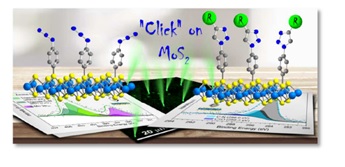
Carbon dots from citric acid and its intermediates formed by thermal decomposition
Plinio Innocenzi, Luca Malfatti, Sergio Marras, Carlo Maria Carbonaro, Gaetano Granozzi, Robert ludmerczki, Laura Calvillo, Stefania Mura, Istvan Mandity, Sebastiamo Garroni, Massimo Carraro, Nina Senes
Chem. Eur. J.2019, (IF: 5.16)
http://dx.doi.org/10.1002/chem.201902497
Thermal decomposition of citric acid is one of the most common syntheses of fluorescent C-dots; the reaction pathway is,however, quite complex and the details are still far from being understood. For instance, several intermediates formduring the processand they alsogive risetofluorescent species. In the present work, the formation of fluorescent C-dots fromcitric acid has been studied as a function of reaction time by coupling infrared analysis, X-ray photoelectron spectroscopy, liquid chromatography/mass spectroscopy (LC/MS) with the change ofthe optical properties, absorption and emission. The reaction intermediates, which have been identifiedat different stages,producetwo main emissive species, in the green andblue, as also indicated by the decay time analysis. C-dots from the intermediateshave also beensynthesised via thermal decomposition observingan emission maximum around 450 nm. The citric acid C-dots in water have shown shorttemporal stability,but their functionalization with 3-aminopropyltriethoxysilane has reduced thequenching.The understanding of the citric acid thermal decomposition reaction is expected toimprove the control and reproducibility of C-dotssynthesis.
Palladium nanoparticles supported on graphene acid: a stable and eco-friendly bifunctional C–C homo- and cross-coupling catalyst
Matías Blanco, Dario Mosconi, Cristina Tubaro, Andrea Biffis, Denis Badocco, Paolo Pastore, Michal Otyepka, Aristides Bakandritsos, Zhibo Liu, Wencai Ren, Stefano Agnoli and Gaetano Granozzi
Green Chem., 2019, (IF: 9.405)
DOI: 10.1039/c9gc01436e
A mild impregnation of graphene acid (GA) with Pd(OAc)2 yields Pd nanoparticles with a size that can be easily controlled by the amount of the Pd precursor, and with a sharp and tunable size distribution ranging from 1 nm up to 9 nm. The spectroscopic and microscopic characterization of the GA–Pd composites reveals a strong interaction between the metal and the carboxyl groups of the GA support, and suggests a nanoparticle growth mechanism entailing counterion metathesis followed by a GA promoted reduction. The GA–Pd nanohybrids are highly active catalysts in the Suzuki–Miyaura cross coupling reaction under environmentally-friendly conditions. TOF values exceeding 30 000 h−1, high selectivity toward the coupling product and versatility for a large variety of substrates are reported.
Given the large amount of carboxyl groups, the catalysts are exceptionally stable, and no appreciable metal leaching is observed during the reaction. Notably, at variance with conventional carbon and graphene supports, the GA supported Pd nanoparticles show a bifunctional activity and can yield biphenyl adducts upon oxidative homocoupling of arylboronic acids.
Surface functionalization of grown-on-tip ZnO nanopyramids: from fabrication to light-triggered applications
Alberto Gasparotto,* Chiara Maccato, Giorgio Carraro, Cinzia Sada, Urška Lavrenčič Štangar, Bruno Alessi, Conor Rocks, Davide Mariotti, Andrea La Porta, Thomas Altantzis, Davide Barreca
ACS Applied Materials & Interfaces (I.F. 8.097)
We report on a combined chemical vapor deposition (CVD)/radio frequency (RF) sputtering synthetic strategy for the controlled surface modification of ZnO nanostructures by Ti-containing species. Specifically, the proposed approach consists in the CVD of grown-on-tip ZnO nanopyramids, followed by titanium RF sputtering under mild conditions. The results obtained by a thorough characterization demonstrate the successful ZnO surface functionalization with dispersed Ti-containing species in low amounts. This phenomenon, in turn, yields a remarkable enhancement of photoactivated superhydrophilic behavior, self-cleaning ability, and photocatalytic performances in comparison to bare ZnO. The reasons accounting for such an improvement are unravelled by a multitechnique analysis, elucidating the interplay between material chemico-physical properties and the corresponding functional behavior. Overall, the proposed strategy stands as an amenable tool for the mastering of semiconductor-based functional nanoarchitectures through ad-hoc engineering of the system surface.
Direct depolymerization coupled to liquid extraction surface analysis high-resolution mass spectrometry for the characterization of the surface of plant tissues
Chiara Giorio, Edwige Moyroud, Beverley J. Glover, and Markus Kalberer
Analytical Chemistry (IF: 6.042)
DOI: 10.1021/acs.analchem.9b01094
The cuticle, the outermost layer covering the epidermis of most aerial organs of land plants, can have a heterogenous composition even on the surface of the same organ. The main cuticle component is the polymer cutin which, depending on its chemical composition and structure, can have different biophysical properties. In this study, we introduce a new on-surface depolymerization method coupled to liquid extraction surface analysis (LESA) high-resolution mass spectrometry (HRMS) for a fast and spatially resolved chemical characterization of the cuticle of plant tissues. The method is composed of an on-surface saponification, followed by extraction with LESA using a chloroform-acetonitrile-water (49:49:2) mixture and direct HRMS detection. The method is also compared with LESA-HRMS without prior depolymerization for the analysis of the surface of the petals of Hibiscus richardsonii flowers, which have a ridged cuticle in the proximal region and a smooth cuticle in the distal region. We found that on-surface saponification is effective enough to depolymerize the cutin into its monomeric constituents thus allowing detection of compounds that were not otherwise accessible without a depolymerization step. The effect of the depolymerization procedure was more pronounced for the ridged/proximal cuticle, which is thicker and richer in epicuticular waxes compared with the cuticle in the smooth/distal region of the petal.
Molecular‐Dynamics‐Simulation‐Directed Rational Design of Nanoreceptors with Targeted Affinity
Xiaohuan Sun, Laura Riccardi, Federico De Biasi, Federico Rastrelli, Marco De Vivo, Fabrizio Mancin
Angew.Chem.Int. Ed. (I.F. 12.102)
DOI: 10.1002/anie.201902316
Published online: May 2, 2019
Here, we demonstrate the possibility of rationally designing nanoparticle receptors with targeted affinity and selectivity for specific small molecules. We used atomistic molecular‐dynamics (MD) simulations to gradually mutate and optimize the chemical structure of the molecules forming the coating monolayer of gold nanoparticles (1.7 nm gold‐core size). The MD‐directed design resulted in nanoreceptors with a 10‐fold improvement in affinity for the target analyte (salicylate) and a 100‐fold decrease of the detection limit by NMR‐chemosensing from the millimolar to the micromolar range. We could define the exact binding mode, which features prolonged contacts and deep penetration of the guest into the monolayer, as well as a distinct shape of the effective binding pockets characterized by exposed interacting points.
Luminescent sequence-dependent materials through a step by step assembly of RE1-1,4-benzendicarboxylate-RE2 (REx = Y3+, Eu3+ and Tb3+) architectures on a silica surface
Luca Bellucci, Gregorio Bottaro, Luca Labella, Fabio Marchetti, Simona Samaritani, Daniela Belli Dell’Amico, Lidia Armelao
JOURNAL OF MATERIALS CHEMISTRY C (IF: 5.976)
DOI: 10.1039/c9tc00181f
We present an approach toward sequence-dependent materials based on a stepwise assembly on a silica surface of rare earth cations (RE: Y3+, Eu3+ and Tb3+) and the 1,4-benzenedicarboxylate (terephthalate, T2-) ligand, organized in an ordered sequence RE1-T-RE2. The first RE was grafted to silica through a reaction of its N,N-dibutylcarbamato derivative, [RE1(O2CNBu2)(3)], with the surface silanols. The residual carbamato groups in the metal coordination sphere were then substituted by HT- through a reaction with H2T in pyridine. The Brönsted acidity of the pendant COOH groups was successively exploited for the anchorage of the second metal ion (RE1 = Eu, RE2 = Tb; RE1 = Y, RE2 = Tb). The choice of pyridine as the solvent, able to dissolve both H2T and the secondary product [NH2Bu2](2)[T]H2T, was crucial for achieving success with this method. The emission properties of the materials were modulated by modifying the order of the synthetic steps. Metal complexes and materials were characterized by IR, EDX, ICP and photoluminescence. We used Tb3+ to Eu3+ energy transfer (ET) to study the RE3+ spatial distribution and intermetal distances to prove the formation of a RE1-T-RE2 sequence. Photoluminescence was used as a multi-tool technique to characterize the functional properties of the materials and to obtain structural information supporting the sequence growth.
Tunable E-Z Photo-Isomerization in a,b-Peptide Foldamers Featuring Multiple (E/Z)-3-Aminoprop-2-enoic Acid Units
Giulia Marafon, Marco Crisma, Alessandro Moretto
Org. Lett., DOI: 10.1021/acs.orglett.9b01360, Publication Date (Web): May 15, 2019
impact factor 6.49
Systems in which an external stimulus elicits a response through some sort of modification at the molecular or supramolecular level bear potential for the development of smart materials and devices. This work describes a versatile synthetic approach suitable for the stepwise incorporation of multiple, even consecutive, units of the simplest Ca,b-unsaturated b-amino acid, (E/Z)-3-aminoprop-2-enoic acid, in peptide-based foldamers. The properties of these latter, including photoinduced E/Z isomerizations, were investigated.
Exploring wet chemistry approaches to ZnFe2O4 spinel ferrite nanoparticles with different inversion degrees: a comparative structural and spectroscopic study
Paolo Dolcet, Kristin Kirchberg, Alice Antonello, Christian Suchomski, Roland Marschall, Stefano Diodati, Rafael Muñoz-Espí, Katharina Landfester, Silvia Gross
Inorg. Chem. Front., Just Accepted Manuscript
I. F.: 5.106
Spinel ferrites (MFe2O4, M being a bivalent metal), are a widely known class of oxides employed in a broad range of applications. It is of the utmost importance to investigate how different synthetic procedures can steer the structural evolution of the target materials, especially with regards to the inversion degree of ZnFe2O4 spinel, since altered properties ascribed to fine (micro)structural differences are common.
In this paper, we synthesised nanocrystalline ZnFe2O4 through three different low-temperature (< 300°C) synthetic approaches: microwave-assisted non-aqueous sol–gel synthesis, hydrothermal synthesis and a combined miniemulsion/hydrothermal approach (these latter two under subcritical conditions). The materials were then thoroughly characterised through complementary analytical methods. Particular attention during this study was focused on the structural evolution over time of the ferrites, in relation to the different employed synthetic approaches, as well as the correlation between different synthetic parameters/methods and the inversion degree of the resulting spinels.
Direct injection liquid chromatography high-resolution mass spectrometry for determination of primary and secondary terrestrial and marine biomarkers in ice cores
Amy King, Chiara Giorio, Eric Wolff, Elizabeth Thomas, Marco Roverso, Margit Schwikowski, Andrea Tapparo, Sara Bogialli, and Markus Kalberer
Analytical Chemistry (IF: 6.042)
DOI: 10.1021/acs.analchem.8b05224
Many atmospheric organic compounds are long-lived enough to be transported from their sources to polar regions and high mountain environments where they can be trapped in ice archives. While inorganic components in ice archives have been studied extensively to identify past climate changes, organic compounds have rarely been used to assess paleo-environmental changes, mainly due to the lack of suitable analytical methods. This study presents a new method of direct injection HPLC-MS analysis, without the need of pre-concentrating the melted ice, for the determination of a series of novel biomarkers in ice-core samples indicative of primary and secondary terrestrial and marine organic aerosol sources. Eliminating a preconcentration step reduces contamination potential and decreases the required sample volume thus allowing a higher time resolution in the archives. The method is characterised by limits of detections (LODs) in the range of 0.01-15 ppb, depending on the analyte, and accuracy evaluated through an interlaboratory comparison. We find that many components in secondary organic aerosols (SOA) are clearly detectable at concentrations comparable to those previously observed in replicate preconcentrated ice samples from the Belukha glacier, Russian Altai Mountains. Some compounds with low recoveries in preconcentration steps are now detectable in samples with this new direct injection method significantly increasing the range of environmental processes and sources that become accessible for paleo-climate studies.
The Aerosols, Radiation and Clouds in southern Africa (AEROCLO-sA) field campaign in Namibia: overview, illustrative observations and way forward
Paola Formenti, Barbara D’Anna, Cyrille Flamant, Marc Mallet, Stuart John Piketh, Kerstin Schepanski, Fabien Waquet, Frédérique Auriol, Gerard Brogniez, Frédéric Burnet, Jean-Pierre Chaboureau, Aurélien Chauvigné, Patrick Chazette, Cyrielle Denjean, Karine Desboeufs, Jean-François Doussin, Nellie Elguindi, Stefanie Feuerstein, Marco Gaetani, Chiara Giorio, Danitza Klopper, Marc Daniel Mallet, Pierre Nabat, Anne Monod, Fabien Solmon, Andreas Namwoonde, Chibo Chikwililwa, Roland Mushi, Ellsworth Judd Welton, and Brent Holben
Bulletin of the American Meteorological Society (IF: 7.804)
DOI: 10.1175/BAMS-D-17-0278.1
The AEROCLO-sA (AErosol, RadiatiOn and CLOuds in southern Africa) project investigates the role of aerosols on the regional climate of southern Africa. This is a unique environment where natural and anthropogenic aerosols and a semi-permanent and widespread stratocumulus (Sc) cloud deck are found. The project aims to understand the dynamical, chemical and radiative processes involved in aerosol-cloud-radiation interactions over land and ocean and under various meteorological conditions.
The AEROCLO-sA field campaign was conducted in August and September of 2017 over Namibia. An aircraft equipped with active and passive remote sensors and aerosol in situ probes performed a total of 30 research flight hours. In parallel, a ground-based mobile station with state-of-the-art in situ aerosol probes and remote sensing instrumentation was implemented over coastal Namibia, and complemented by ground-based and balloon-borne observations of the dynamical, thermodynamical and physical properties of the lower troposphere. The focus laid on mineral dust emitted from salty pans and ephemeral riverbeds in northern Namibia, the advection of biomass burning aerosol plumes from Angola subsequently transported over the Atlantic Ocean, and aerosols in the marine boundary layer at the ocean-atmosphere interface.
This article presents an overview of the AEROCLO-sA field campaign with results from the airborne and surface measurements. These observations provide new knowledge of the interactions of aerosols and radiation in cloudy and clear skies in link with the atmospheric dynamics over southern Africa. They will foster new advanced climate simulations and enhance the capability of space-borne sensors, ultimately allowing a better prediction of future climate and weather in southern Africa.
Nanoparticle-assisted NMR spectroscopy: Enhanced detection of analytes by water mediated saturation transfer
Federico De Biasi, Daniele Rosa-Gastaldo, Xiaohuan Sun, Fabrizio Mancin, and Federico Rastrelli
J. Am. Chem. Soc. (I.F. 14.357)
DOI: 10.1021/jacs.8b13225
Accepted: 20 Feb 2019
Nanoparticle-assisted “NMR chemosensing” is an experimental protocol that exploits the selective recognition abilities of nanoparticle receptors to detect and identify small molecules in complex mixtures by NOE magnetization transfer. While the intrinsic sensitivity of the first reported protocols was modest, we have now found that water spins in long-lived association at the nanoparticle monolayer constitute an alternative source of magnetization that can deliver a remarkable boost of sensitivity, especially when combined with saturation transfer experiments. The approach is general and can be applied to analyte-nanoreceptor systems of different compositions. In this work we provide an account of the new method and we propose a generalized procedure based on a joint water-nanoparticle saturation to further upgrade the sensitivity, which ultimately endows selective analyte detection down to the micromolar range on standard instrumentation.
Hierarchical organization of perylene bisimides and polyoxometalates for photo-assisted water oxidation
Marcella Bonchio, Zois Syrgiannis, Max Burian, Nadia Marino, Erica Pizzolato, Konstantin Dirian, Francesco Rigodanza, Giulia Alice Volpato, Giuseppina La Ganga, Nicola Demitri, Serena Berardi, Heinz Amenitsch, Dirk M. Guldi, Stefano Caramori, Carlo Alberto Bignozzi, Andrea Sartorel & Maurizio Prato
Nature Chemistry (2018)
DOI: 10.1038/s41557-018-0172-y
The oxygen in Earth’s atmosphere is there primarily because of water oxidation performed by photosynthetic organisms using solar light and one specialized protein complex, photosystem II (PSII). High-resolution imaging of the PSII ‘core’ complex shows the ideal co-localization of multi-chromophore light-harvesting antennas with the functional reaction centre. Man-made systems are still far from replicating the complexity of PSII, as the majority of PSII mimetics have been limited to photocatalytic dyads based on a 1:1 ratio of a light absorber, generally a Ru–polypyridine complex, with a water oxidation catalyst. Here we report the self-assembly of multi-perylene-bisimide chromophores (PBI) shaped to function by interaction with a polyoxometalate water-oxidation catalyst (Ru4POM). The resulting [PBI]5Ru4POM complex shows a robust amphiphilic structure and dynamic aggregation into large two-dimensional paracrystalline domains, a redshifted light-harvesting efficiency of >40% and favourable exciton accumulation, with a peak quantum efficiency using ‘green’ photons (λ > 500 nm). The modularity of the building blocks and the simplicity of the non-covalent chemistry offer opportunities for innovation in artificial photosynthesis.
Arene CH insertion catalyzed by ferrocene covalently heterogenized on graphene acid
Dario Mosconi, Matías Blanco, Teresa Gatti, Laura Calvillo, Michal Otyepka, Aristides Bakandritsos, Enzo Menna, Stefano Agnoli and Gaetano Granozzi
Carbon (IF= 7.082)
DOI: doi.org/10.1016/j.carbon.2018.11.010
Accepted on 05th November 2018
The heterogenation of molecular catalysts on solid supports is a viable route for the preparation of hybrid materials that combine the high selectivity and activity of homogeneous active species with the enhanced stability and recyclability imparted by the heterogeneous nature of the support. The paper describes the covalent functionalization with ferrocene (Fc) of two graphene derivatives: graphene acid (GA), a graphene layer whose basal plane is modified with COOH groups but maintaining the electronic and thermal conductivity of pristine graphene, and graphene oxide (GO) as already known oxidized carbon nanomaterial benchmark. The surface modification is performed exploiting the carbodiimide chemistry, which allows introducing up to 3.6 % at. of iron in the GA-based material. Compared to GO, GA owns a superior functionalization degree, which is attributed to its controlled surface chemistry. Both Fc-modified materials are tested as catalysts in the C-H insertion of diazonium salts employing arene substrates. The materials are active, versatile and recyclable catalysts that show a catalytic performance comparable to or even better than molecular Fc, together with a 100% recyclability which does not alter the catalytic performance. The GA-based hybrid catalyst results more active than that based on GO due to the presence of more extended aromatic domains (higher electron conductivity) that facilitate the synergy due to local adsorption phenomena able to sort reagents close to the active sites.
Substrate-Induced Self-Assembly of Cooperative Catalysts
Pablo Solís Muñana, Giulio Ragazzon, Julien Dupont,Chloe Z.-J. Ren, Leonard J. Prins, Jack L.-Y. Chen
Angewandte Chemie (IF: 12.1)
DOI: 10.1002/anie.201810891
Dissipative self-assembly processes in Nature rely on chemical fuels that activate proteins for assembly through the formation of a noncovalent complex. The catalytic activity of the assemblies causes fuel degradation, resulting in the formation of an assembly in a high-energy, out-of-equilibrium state. Herein, we apply this concept to a synthetic system and demonstrate that a substrate can induce the formation of vesicular assemblies, which act as cooperative catalysts for cleavage of the same substrate.
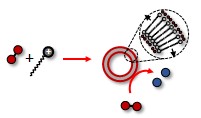
Surface Engineering of Chemically Exfoliated MoS2 in a “Click”: How to Generate Versatile Multifunctional Transition Metal Dichalcogenides-Based Platforms
Giulia Tuci, Dario Mosconi, Andrea Rossin, Lapo Luconi, Stefano Agnoli, Marcello Righetto, Cuong Pham-Huu, Housseinou Ba, Stefano Cicchi, Gaetano Granozzi,* and Giuliano Giambastiani*
Chemistry of Materials (IF= 9.890)
DOI: 10.1021/acs.chemmater.8b03663
Accepted on 11 October 2018
The interest for transition metal dichalcogenides (TMDs) as two-dimensional (2D) analogues of graphene is steadily growing along with the need of efficient and easy tunable protocols for their surface functionalization. This latter aspect holds a key role in the widespread application of TMDs in various technological fields and it represents the missing step to bridge the gap between the more popular Csp2-based networks and their inorganic counterparts. Although significant steps forward have already been made in the field of TMDs functionalization (particularly for MoS2), a rational approach to their surface engineering for the generation of 2D organic-inorganic hybrids capable to accommodate various molecules featured by orthogonal groups has not been reported yet. The paper paves the way towards a new frontier for “click" chemistry in material science. It describes the post-synthetic modification (PSM) of covalently decorated MoS2 nanosheets with phenylazido pendant arms and the successful application of CuAAC chemistry (copper-mediated azide-alkyne cycloaddition) towards the generation of highly homo- and hetero-decorated MoS2 platforms. This contribution goes beyond the proof of evidence of the chemical grafting of organic groups to the surface of exfoliated MoS2 flakes through covalent C-S bonds. It also demonstrates the versatility of the hybrid samples to undergo post-synthetic modifications thus imparting multimodality to these 2D materials.

Intrinsically Photoswitchable a/b Peptides Toward Two-State Foldamers
Giulia Marafon, Marco Crisma, Alessandro Moretto
Angewandte Chemie, just accepted (26-06-2018)
DOI: 10.1002/anie.201806035
I.F. 11.994
A simple, unsaturated, E-Z photoisomerizable -amino acid, (Z)-3-aminoprop-2-enoic acid, has been introduced into peptide foldamers via a one-pot chemical coupling, based on Pd/Cu-catalyzed olefin oxidative amidation, between two peptide segments carrying, respectively, a -Gly-NH2 residue at the C-terminus and an acryloyl group at the N-terminus. Reversible conversion between the Z and E configurations of the 3-aminoprop-2-enoic linkage was achieved photochemically. A crystallographic analysis on two model compounds shed light on the consequences, in terms of 3D-structure and self-association properties, brought about by the different configuration of the unsaturated linkage. As a proof of concept, E-Z photoisomerization of a 3-aminoprop-2-enoic acid residue, inserted as the junction between two conformationally distinct peptide domains (one helical while the other -sheet promoter), allowed supramolecular self-association to be reversibly turned on/off.
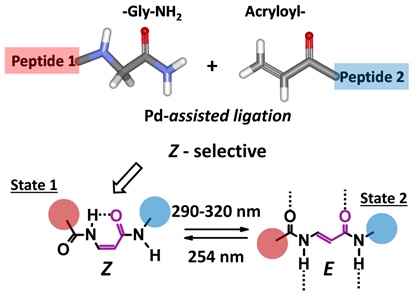
Energy consumption in chemical-fuel driven self-assembly
Giulio Ragazzon, Leonard Prins
Nature Nanotechnology (IF = 37.5)
DOI: 10.1038/s41565-018-0250-8
Nature extensively exploits dissipative self-assembly for the transient formation of highenergy structures able to perform work. Often, self-assembly relies on the use of high-energy molecules as fuel which is consumed to drive thermodynamically unfavourable reactions far away from equilibrium. Mastering nonequilibrium rocesses and their implementation in synthetic selfassembly will facilitate a paradigm shift in the fields of chemistry, materials science and synthetic biology leading towards innovative structures able to store and convert chemical energy. Yet, despite increasing efforts, the basic principles underlying dissipative, and especially chemical fuel driven, self-assembly are often overlooked. Here, we bridge the gap between current experimental approaches and conceptual frameworks. Strategies for storing energy in thermodynamically activated structures are discussed and a rational platform for chemical fuel driven adaptation is provided. From the analysis emerges an insight on how energy consumption processes may have played a crucial role in evolutionary processes.
Colloidally Confined Crystallization of Highly Efficient Ammonium Phosphomolybdate Catalysts
Antonello, Alice; Benedetti, Cesare; Perez-Pla, Francisco; Kokkinopoulou, Maria; Kirchhoff, Katrin; Fischer, Viktor; Landfester, Katharina; Gross, Silvia; Muñoz-Espí, Rafael
ACS Applied Materials & Interfaces
I.F. 7.504
Just accepted manuscript
DOI:
Nanodroplets in inverse miniemulsions provide a colloidal confinement for the crystallization of ammonium phosphomolybdate, influencing the resulting particle size. The effects of the space confinement are investigated by comparing the crystallization of analogous materials both in miniemulsion and in bulk solution. The catalytic activity of the materials is studied taking the epoxidation of cis-cyclooctene as a model reaction. The miniemulsion route yields ammonium phosphomolybdate particles catalytically much more active than analogous samples produced in bulk solution, which can be explained by their higher dispersibility in organic solvents, their higher surface area, and their higher porosity. In addition, the catalysts prepared in miniemulsion display a promising recyclability.
Switching From Reactant to Substrate Engineering in the Selective Synthesis of Graphene Nanoribbons
Néstor Merino-Díez, Jorge Lobo-Checa, Pawel Nita, Aran Garcia-Lekue, Andrea Basagni, Guillaume Vasseur, Federica Tiso, Francesco Sedona, Pranab K. Das, Jun Fujii, Ivana Vobornik, Mauro Sambi, José Ignacio Pascual, J. Enrique Ortega and Dimas G. de Oteyza
J. Phys. Chem Lett.
I.F. 9.353
Publication date (online): April 24, 2018
DOI: 10.1021/acs.jpclett.8b00796
The challenge of synthesizing graphene nanoribbons (GNRs) with atomic precision is currently being pursued along a one-way road, based on the synthesis of adequate molecular precursors that react in predefined ways through self-assembly processes. The synthetic options for GNR generation would multiply by adding a new direction to this readily successful approach, especially if both of them can be combined. We show here how GNR synthesis can be guided by an adequately nanotemplated substrate instead of by the traditionally designed reactants. The structural atomic precision, unachievable to date through top-down methods, is preserved by the self-assembly process. This new strategy´s proof-of-concept compares experiments using 4,4´´-dibromo-para-terphenyl as molecular precursor on flat Au(111) and stepped Au(322) substrates. As opposed to the former, the periodic steps of the latter drive the selective synthesis of 6 atom-wide armchair GNRs, whose electronic properties have been further characterized in detail by scanning tunneling spectroscopy, angle resolved photoemission and density functional theory calculations.
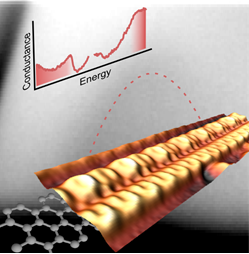
Highly efficient MoS2/Ag2S/Ag photo-electrocatalyst obtained from a recycled DVD surface
Tomasz Kosmala, Dario Mosconi, Giuseppe Giallongo, Gian Andrea Rizzi*, and Gaetano Granozzi
ACS Sustainable Chemistry & Engineering
DOI: 10.1021/acssuschemeng.8b00840
IF = 5.951
An efficient photo-electrocatalyst for Hydrogen Evolution Reaction (HER) was prepared by electrochemical deposition of MoS2 on the Ag nanostructured surface of a commercial writable
Digital Versatile Disc (DVD). The deposition was performed by reduction of MoS42- ions and the concomitant production of HS- ions led to the formation of Ag2S nanoparticles. The result
was a composite material MoS2/Ag2S/Ag characterized by the formation of uniformly distributed n-p nanojunctions that make the performances of this easy to prepare and cheap electrocatalyst comparable or better than those of similar MoS2 based systems. This study suggests a viable opportunity to turn an abundant waste into an added-value material.
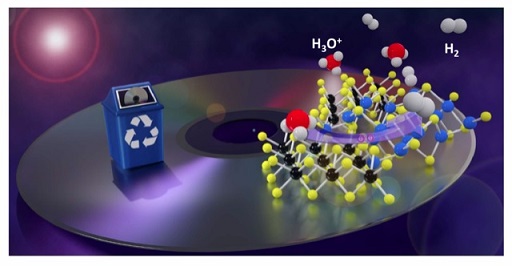
Metallic Twin Boundaries Boost the Hydrogen Evolution Reaction on the Basal Plane of Molybdenum Selenotellurides
omasz Kosmala, Horacio Coy Diaz, Hannu‐Pekka Komsa, Yujing Ma, Arkady V. Krasheninnikov, Matthias Batzill, and Stefano Agnoli
Advanced Energy Materials
DOI: 10.1002/aenm.201800031
I.F.: 16.721
The hydrogen evolution reaction (HER) is a fundamental process that impacts several important clean energy technologies. Great efforts have been taken to identify alternative materials that could replace Pt for this reaction or that may present additional functional properties such as optical activity and advanced electronic properties. We report a comparative study of the HER activity for ultrathin films of MoTe2, MoSe2, and their solid solutions on highly oriented pyrolytic graphite. Combining advanced characterization techniques (STM, AFM, XPS, UPS) and density functional theory calculations with electrochemical measurements, we demonstrate that the chemical activity of the scarcely reactive 2H phases can be boosted by the presence of metallic twin boundaries that are obtained when these materials are deposited by MBE as thin films. This novel strategy is similar to the exploitation of 1T polymorphs in WS2 and MoS2 that have metallic properties and therefore show HER activity not only at edges but also in the basal plane. However, these phases are metastable and inevitably degrade with time. Metallic twin boundaries on the contrary, are the most thermodynamically stable defects in slightly Mo-enriched MoTe2 and therefore are expected to provide materials with better stability. Their special electronic structure and versatile geometry made them quite interesting to impart TMCs at the nano- or macroscale, with special functional properties such as metallic conductions and unprecedented chemical activity. For the first time, we demonstrated their potential for boosting the HER activity in tellurides, however their presence in several chalcogenides (i.e. MoSe2, MoS2, WSe2, WS2) suggests that the same effect can be reproduced on several other materials. Therefore, the control of MTBs offers a quite versatile tool for the development of advanced multifunctional materials with improved electronic properties and special chemical activity.
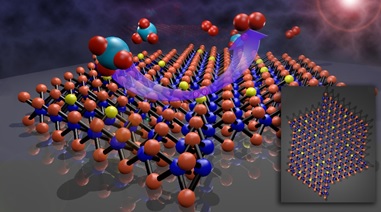
Very fast crystallisation of MFe2O4 spinel ferrites (M=Co, Mn, Ni, Zn) under low temperature hydrothermal conditions: a time-resolved structural investigation
Paolo Dolcet, Stefano Diodati, Federico Zorzi, Pascal Voepel, Christoph Seitz, Bernd M. Smarsly, Simone Mascotto, Fabrizio Nestola, and Silvia Gross
Green Chemistry, Just accepted (DOI: 10.1039/C8GC00086G)
I. F. : 9.125
MFe2O4 spinel ferrites (M=Co, Mn, Ni, Zn) were synthesised through a low-temperature aqueous route combining co-precipitation of oxalates and hydrothermal treatment at 135°C. To gain a deeper understanding of the structural evolution of the compounds to crystalline material during the synthetic process, samples were characterised through several time-resolved state-of-the-art analytical techniques, both on the atomic (XAS) and mesoscopic (XRPD, SAXS) scale. Experimental outcomes reveal that in most cases a fully crystalline habit already forms after short treatment times. By varying the thermal treatment duration is it possible to modulate the inversion degree of the ferrites. In parallel, temperature-programmed characterisation was carried out to investigate the evolution of the compounds during the heating process.
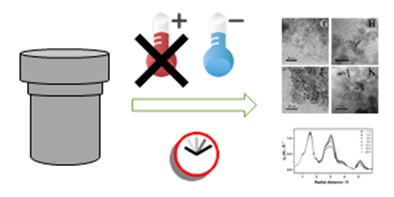
Insights into the durability of Co-Fe spinel oxygen evolution electrocatalysts via operando studies of catalyst structure
Laura Calvillo, Francesco Carraro, O. Vozniuk, V. Celorrio, L. Nodari, A. E. Russell, D. Debellis, D. Fermin, F. Cavani, S. Agnoli and G. Granozzi
Journal of Materials Chemistry A
DOI: 10.1039/C7TA10892C
(I.F.= 8.867)
Co-Fe spinels (CoxFe3-xO4, x = 0.6, 1, 2) are prepared both as model (ultrathin film) and realistic (powder) catalysts. Elemental reorganisation and oxidation state changes of key active sites in Co-Fe spinels are investigated by in situ X-ray photoemission spectroscopy (XPS) and operando X-ray absorption spectroscopy (XAS) under oxygen evolution operating conditions. The combination of these two in situ techniques and post-mortem XPS, TEM and Mössbauer spectroscopy, allow to identify both the surface and bulk modifications on the oxides and relate them to the activity loss during extended cycling. The results show that Co-Fe spinels experience a surface irreversible phase evolution under oxygen evolution reaction (OER) conditions, resulting in the formation of an amorphous layer composed of Co3O4, CoOOH and Fe2O3. The extension of this oxidation depends on the composition and cation distribution of the spinel oxides, since the Co(II) cations in Td sites are those that experience the modifications. Accelerated ageing tests show that the durability, intended as the performance loss during cycling treatments, is not directly related to the structural/chemical stability of the spinels but to the new species formed at the surface due to the electrochemical work. Thus, the material that experienced more significant changes was also the most durable one, demonstrating that the understanding of the chemical and/or structural evolution of the materials during the catalytic process can be the key for the design of highly active and stable catalysts.
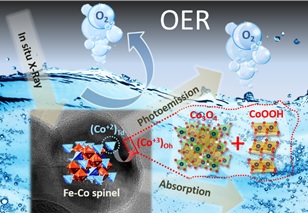
Layered cesium copper titanate for photocatalytic hydrogen production
Martin Pilarski, Roland Marschall, Silvia Gross, Michael Wark
Appl. Cat. B: Environmental, Just accepted manuscript
I. F.: 9.446
Layered cesium copper titanate as well as the unmodified cesium titanate Cs0.68Ti1.83□0.17O4 (□: vacancy) were synthesized by a solution-based approach. The insertion of small amounts of copper into the vacancies of Cs0.68Ti1.83□0.17O4 led to a significant red shift of the band gap energy from 3.4 eV to 2.9 eV. During photocatalytic H2 production experiments, a steady increase in the evolution rate was detected, which can be referred to the in-situ reduction of incorporated copper ions to metallic Cu. As shown by XPS, the reduced copper ions leach out of the lattice to the catalyst surface and act as co-catalyst for H2 formation, considerably exceeding the activity achieved with Cs0.68Ti1.83□0.17O4 modified with 0.075 wt.-% of Rh as co-catalyst.
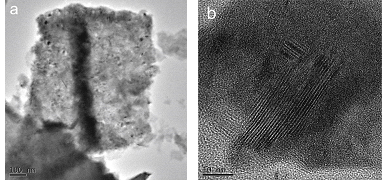
Enhancing the oxygen electroreduction activity through electron tunnelling: CoOx ultrathin films on Pd(100)
Tomasz Kosmala, Laura Calvillo, Stefano Agnoli and Gaetano Granozzi
ACS Catalysis 2018, DOI: 10.1021/acscatal.7b02690 (I.F.= 10.614)
Electron transfer is the most crucial step in several electrochemical reactions, therefore finding alternative ways for its control represents a huge step toward the design of advanced electrocatalytic materials. We demonstrate that the electrons from an oxide-buried metal interface can be efficiently exploited in electrochemical reactions. This is proven by studying the electrochemical activity of model systems constituted by cobalt oxide ultrathin (<2nm) films epitaxially grown on Pd(100). Metal/metal oxide interfacial hybridization and electron tunnelling from the metal substrate through the oxide endow CoOx ultrathin films with exceptional electrochemical activity and improved methanol poison tolerance. In situ XPS and Raman measurements indicate that during the oxygen reduction reaction, CoOx films are oxidized by oxygen: Co3O4/CoO is fully converted to a spinel phase, whereas CoO is transformed via the transient formation of Co(OH)2 to a mixed Co3O4/CoOOH phase. The study of different oxide film thickness shows the crucial role of the substrate. At the UT regime, the performance of cobalt oxide is essentially analogous to that of Pd(100), because the electrons from the metal substrate can tunnel through the oxide and reduce the oxygen on the electrode surface. On the other hand, as the oxide thickness increases, tunnelling is suppressed and the ORR activity is significantly reduced. Therefore, UT oxide films supported on metals represent an innovative class of materials for electrochemistry applications that show properties not available in a single material. These results demonstrate that the in situ study of ultrathin films on single crystals is a powerful method for the identification of materials active phase and of novel phenomena such as electron tunnelling.
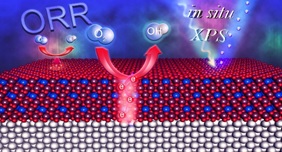
The Renaissance of Fullerenes with Perovskite Solar Cells
T. Gatti, E. Menna, M. Meneghetti, M. Maggini, A. Petrozza, F. Lamberti
Journal: Nano Energy (IF: 12.343)
DOI: 10.1016/j.nanoen.2017.09.016
Fullerenes have been extensively used for more than two decades for the development of organic photovoltaics (OPV). While OPV seems to be a technology almost ready for the market, in the last few years fullerenes are attracting a big interest for the improvement they afford on the already well-performing perovskite solar cells (PSCs). Thanks to PSC integration, interest in fullerenes is rising again, opening up new exciting perspectives for photovoltaics. This review article aims at analyzing the landmark contributions that gave birth to the novel application of fullerenes in PSCs and to the technological solutions that are emerging with them.
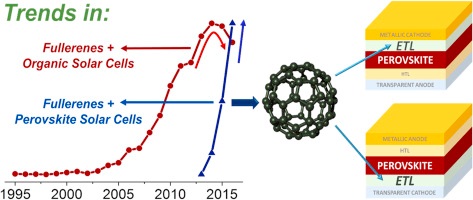
A D-π-A organic dye - reduced graphene oxide covalent dyad as a new concept photosensitizer for light harvesting applications
T. Gatti, N. Manfredi, C. Boldrini, F. Lamberti, A. Abbotto, E. Menna
Journal: Carbon (IF: 6.337)
DOI: 10.1016/j.carbon.2017.01.081
We report here the first example of a covalent functional nanocarbon hybrid based on a benchmark metal-free donor-π-acceptor (D-π-A) dye and reduced graphene oxide (RGO). The dyad, prepared by direct arylation of the RGO surface by means an aniline derivative of the D-π-A species, has been thoroughly characterized in terms of dye loading percentage and spectroscopic properties, in comparison with the reference free dye, pristine RGO, and with an analogous non-covalent dye-RGO hybrid. When used as a photosensitizing agent in dye-sensitized solar cells (DSSC), the covalent hybrid demonstrated lower photovoltaic performances compared to the cell with the reference dye, a result that was mostly ascribed to the lower dye content of the former. Furthermore, the RGO based sensitizer showed stronger binding to the semiconductor oxide in comparison to the reference dye, paving the way to a new generation of DSSC photoanodes with improved chemical stability. This work demonstrates the full potential of the new class of hybrid sensitizers to equal or even exceed the photovoltaic performances achieved by standard organic photovoltaic sensitizers once molecular engineering of the functional nanocarbon hybrid has been refined.
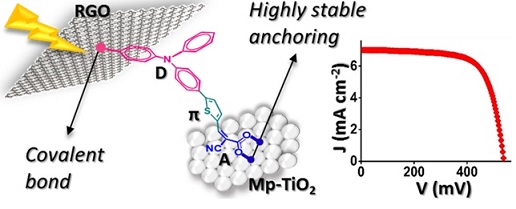
Boosting perovskite solar cells performance and stability through doping a poly-3(hexylthiophene) hole transporting material with organic functionalized carbon nanostructures
T. Gatti, S. Casaluci, M. Prato, M. Salerno, F. Di Stasio, A. Ansaldo, E. Menna, A. Di Carlo, F. Bonaccorso
Adv. Funct. Mater. (IF: 12.124)
DOI: 10.1002/adfm.201602803
Perovskite solar cells (PSCs) are demonstrating great potential to compete with second generation photovoltaics. Nevertheless, the key issue hindering PSCs full exploitation relies on their stability. Amongst the strategies devised to overcome this problem, the use of carbon nanostructures (CNSs) as hole transporting materials (HTMs) has given impressive results in terms of solar cells stability to moisture, air oxygen and heat. In this work, we propose the use of a HTM based on a poly(3-hexylthiophene) (P3HT) matrix doped with organic functionalized single walled carbon nanotubes (SWCNTs) and reduced graphene oxide in PSCs to achieve higher η (11% and 7.3%, respectively) and prolonged shelf-life stabilities (480 h) in comparison with a benchmark PSC fabricated with a bare P3HT HTM (η = 4.3% at 480 h). Further endurance test, i.e., up to 3240 h, have shown the failure of all the PSCs based on un-doped P3HT, while, on the contrary, a η of ~ 8.7% is still detected from devices containing 2wt% SWCNT-doped P3HT as HTM. We attribute the increase in photovoltaic performances and stabilities of the P3HT-CNSs-based solar cell with respect to the standard P3HT-based one to the improved interfacial contacts between the doped HTM and the adjacent layers.
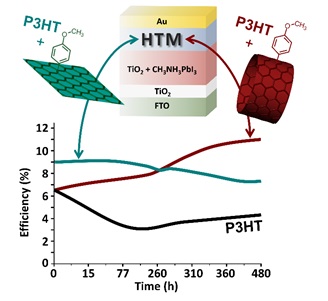
Covalent functionalization enables good dispersion and anisotropic orientation of multi-walled carbon nanotubes in a poly(L-lactic acid) electrospun nanofibrous matrix boosting neuronal differentiation
N. Vicentini, T. Gatti, P. Salice, G. Scapin, C. Marega, F. Filippini, E. Menna
Journal: Carbon (IF: 6.337)
DOI: 10.1016/j.carbon.2015.08.094
A biocompatible porous scaffold obtained via electrospinning a nanocomposite solution of poly(L-lactic acid) and 4-methoxyphenyl functionalized multi-walled carbon nanotubes is presented here for the first time for the enhancement of neurite outgrowth. Optimization of blend preparation and deposition parameters paves the way to the obtainment of defect-free random networks of nanofibers with homogeneous diameters in the hundreds of nanometers length scale. The tailored covalent functionalization of nanotube surfaces allows a homogeneous dispersion of the nanofillers within the polymer matrix, diminishing their natural tendency to aggregate and form bundles. This results in a remarkable effect on the crystallization temperature, as evidenced through differential scanning calorimetry. Furthermore, transmission electron microscopy shows carbon nanotubes anisotropically aligned along the fiber axes, a feature believed to enhance neurite adhesion and growth. Indeed, microscopy images show neurites extension along the direction of nanofibers, highlighting the extreme relevance of scaffold morphology in engineering complex tissue environments. Furthermore, a remarkable effect on increasing the neurite outgrowth results when using the fibrous scaffold containing dispersed carbon nanotubes in comparison with an analogous one made of only polymer, providing further evidence of the key role played by carbon nanostructures in inducing neuronal differentiation.
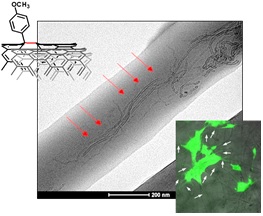
NMR quantification of carbohydrates in complex mixtures. A challenge on honey
Elisabetta Schievano, Marco Tonoli, and Federico Rastrelli
Analytical Chemistry (I.F. 6.320)
DOI: 10.1021/acs.analchem.7b03656
Publication Date (Web): November 7, 2017
The knowledge on carbohydrates composition is of great importance to determine the properties of natural matrices such as food-stuff and food ingredients. However, due to the structural similarity and the multiple isomeric forms of carbohydrates in solution, their analysis is often a complex task. Here we propose an NMR analytical procedure based on highly selective chemical shift fil-ters followed by TOCSY, which allows to acquire specific background-free signals for each sugar. The method was tested on raw honey samples dissolved in water with no other pre-treatment. Twenty two sugars typically found in honey were quantified: four monosaccharides (glucose, fructose, mannose, rhamnose), eleven disaccharides (sucrose, trehalose, turanose, maltose, maltulose, palatinose, melibiose and melezitose, isomaltose, gentiobiose nigerose and kojibiose) and seven trisaccharides (raffinose, isomalto-triose, erlose, melezitose, maltotriose, panose and 1-kestose). Satisfactory results in terms of limit of quantification (0.03 – 0.4 g/100g honey), precision (% RSD: 0.99 – 4.03), trueness (bias % 0.4 – 4.2) and recovery (97 – 104 %) were obtained. An accurate control of the instrumental temperature and of the sample pH endows an optimal chemical shift reproducibility, making the proce-dure amenable to automation and suitable to routine analysis. While validated on honey, which is one of the most complex natural matrices in terms of saccharides composition, this innovative approach can be easily transferred to other natural matrices.
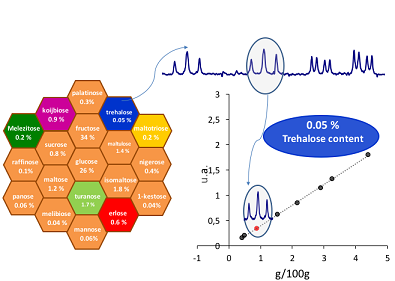
Molybdenum-doping augments platinum-copper oxygen reduction electrocatalyst
Yun Luo, Björn Kirchhoff, Donato Fantauzzi, Laura Calvillo, Luis Alberto Estudillo-Wong, Gaetano Granozzi, Timo Jacob, and Nicolas Alonso-Vante
ChemSusChem 2017, DOI: 10.1002/cssc.201701822 (I.F.= 7.226)
Improving the efficiency of Pt-based oxygen reduction reaction (ORR) catalysts while also reducing costs remains an important challenge in energy research. To this end, we synthesized highly stable and active carbon-supported Mo-doped PtCu (Mo-PtCu/C) nanoparticles (NPs) from readily available precursors in a facile one-pot reaction. Mo-PtCu/C displays two- to four-fold higher ORR half-cell kinetics than reference PtCu/C and Pt/C materials – a trend which was confirmed in proof-of-concept experiments using a H2/O2 micro-laminar fuel cell. This Mo-induced activity increase mirrors observations for Mo-PtNi/C NPs and possibly suggests an emerging trend. Electrochemical accelerated stability tests revealed that dealloying is greatly reduced in Mo-PtCu/C in contrast to the binaries PtCu/C and PtMo/C. Supporting DFT studies suggest that Mo-PtCu’s exceptional stability can be attributed to oxidative resistance of Mo-doped atoms. Furthermore, our calculations revealed that oxygen can induce segregation of Mo to the catalytic surface where it effects beneficial changes to the surface’s oxygen adsorption energetics in context of the Sabatier principle.
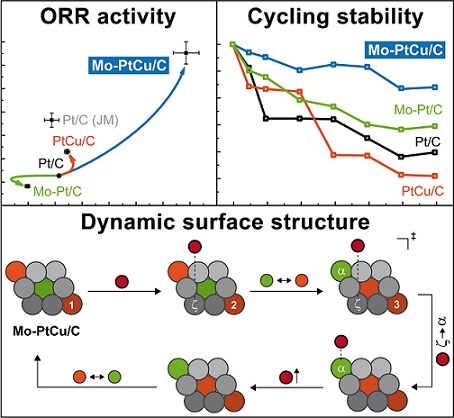
Cobalt Spinel Nanocubes on N-doped Graphene: A Synergistic Hybrid Electrocatalyst for the Highly Selective Reduction of Carbon Dioxide to Formic Acid
Pandiaraj Sekar, Laura Calvillo, Cristina Tubaro, Marco Baron, Anuj Pokle, Francesco Carraro, Alex Martucci and Stefano Agnoli
ACS Catalysis 2017, DOI: 10.1021/acscatal.7b02166 (I.F.= 10.614)
Carbon dioxide reduction into useful chemical products is a key technology to address urgent climate and energy challenges. In this study, a nanohybrid made by Co3O4 and graphene is proposed as an efficient electrocatalyst for the selective reduction of CO2 to formate at low overpotential. The comparison between samples with different metal oxide to carbon ratio and with or without doping of the graphene moiety, indicates that the most active catalyst is formed by highly dispersed and crystalline nanocubes exposing {001} oriented surfaces, whereas the nitrogen doping is critical to obtain a controlled morphology and to facilitate a topotactic transformation during electrocatalytic conditions to CoO, which results to be the true active phase. The nanohybrid made up by intermediate loading of Co3O4 supported on Nitrogen doped graphene is the most active catalyst, being able to produce 3.14 mmol of formate in 8 h at -0.95 V vs SCE with a faradic efficiency of 83%

Ecotoxicological risk assessment for the herbicide glyphosate to non-target aquatic species: A case study with the mussel Mytilus galloprovincialis
Valerio Matozzo a, Jacopo Fabrello, Luciano Masiero, Federico Ferraccioli, Livio Finos, Paolo Pastore, Iole Maria Di Gangi, Sara Bogialli
IF 5.099
Accepted 25 October 2017
DOI: https://doi.org/10.1016/j.envpol.2017.10.100
Glyphosate (GLY) is one of the most used herbicide worldwide. Considering that information concerning the impact of GLY on bivalves is scarce, in this study we evaluated for the first time the effects of environmentally realistic concentrations of GLY (10, 100 and 1000 mg/L) to the mussel Mytilus galloprovincialis. Mussels were exposed for 7, 14 and 21 days and several biomarkers were measured in haemocytes/haemolymph (total haemocyte counts, haemocyte diameter and volume, haemolymph pH, haemolymph lactate dehydrogenase activity, haemocyte lysate lysozyme and acid phosphatase activities), as well as in gills and digestive gland (antioxidant enzyme and acetylcholinesterase activities). The concentrations of GLY and its main metabolite aminomethylphosphonic acid in the experimental tanks were also measured. The MANOVA analysis demonstrated that the experimental variables considered (exposure concentration, exposure duration, and their interaction) affected significantly biomarker responses. In addition, the two-way ANOVA analysis indicated that GLY was able to affect most of the cellular parameters measured, whereas antioxidant enzyme activities resulted to be influenced moderately. Interestingly, exposure to GLY reduced significantly acetylcholinesterase activity in gills. Although preliminary, the results of this study demonstrated that GLY can affect both cellular and biochemical parameters in mussels, highlighting a potential risk for aquatic invertebrates.
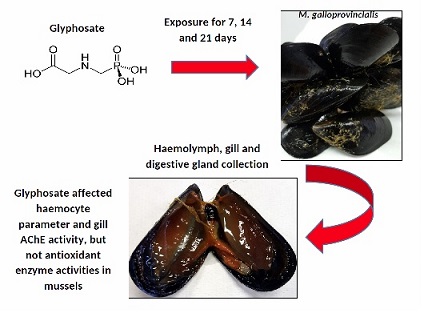
Ecotoxicological risk assessment for the herbicide glyphosate to non-target aquatic species: A case study with the mussel Mytilus galloprovincialis
Valerio Matozzo a, Jacopo Fabrello, Luciano Masiero, Federico Ferraccioli, Livio Finos, Paolo Pastore, Iole Maria Di Gangi, Sara Bogialli
IF 5.099
Accepted 25 October 2017
DOI: https://doi.org/10.1016/j.envpol.2017.10.100
Glyphosate (GLY) is one of the most used herbicide worldwide. Considering that information concerning the impact of GLY on bivalves is scarce, in this study we evaluated for the first time the effects of environmentally realistic concentrations of GLY (10, 100 and 1000 mg/L) to the mussel Mytilus galloprovincialis. Mussels were exposed for 7, 14 and 21 days and several biomarkers were measured in haemocytes/haemolymph (total haemocyte counts, haemocyte diameter and volume, haemolymph pH, haemolymph lactate dehydrogenase activity, haemocyte lysate lysozyme and acid phosphatase activities), as well as in gills and digestive gland (antioxidant enzyme and acetylcholinesterase activities). The concentrations of GLY and its main metabolite aminomethylphosphonic acid in the experimental tanks were also measured. The MANOVA analysis demonstrated that the experimental variables considered (exposure concentration, exposure duration, and their interaction) affected significantly biomarker responses. In addition, the two-way ANOVA analysis indicated that GLY was able to affect most of the cellular parameters measured, whereas antioxidant enzyme activities resulted to be influenced moderately. Interestingly, exposure to GLY reduced significantly acetylcholinesterase activity in gills. Although preliminary, the results of this study demonstrated that GLY can affect both cellular and biochemical parameters in mussels, highlighting a potential risk for aquatic invertebrates.
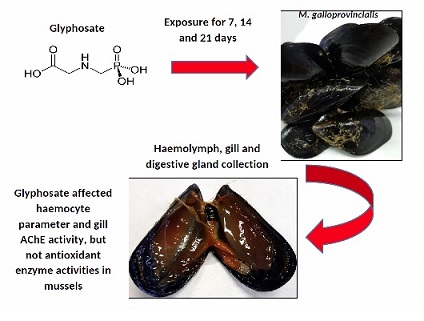
Width-Dependent Band Gap in Armchair Graphene Nanoribbons Reveals Fermi Level Pinning on Au(111)
Néstor Merino-Díez, Aran Garcia-Lekue, Eduard Carbonell-Sanromà, Jingcheng Li, Martina Corso, Luciano Colazzo, Francesco Sedona, Daniel Sánchez-Portal, Jose Ignacio Pascual, and Dimas G. de Oteyza
ACS Nano (IF: 13.942)
DOI: 10.1021/acsnano.7b06765
We report on the energy level alignment evolution of valence and conduction bands of armchair-oriented graphene nanoribbons (aGNR) as their band gap shrinks with increasing width. We use 4,4’’-dibromo-para-terphenyl as molecular precursor on Au(111) to form extended poly-para-phenylene nanowires, which can be fused sideways to form atomically precise aGNRs of varying widths. We measure the frontier bands by means of scanning tunneling spectroscopy, corroborating that the nanoribbon’s band gap is inversely proportional to their width. Interestingly, valence bands are found to show Fermi level pinning as the band gap decreases below a threshold value around 1.7 eV. Such behavior is of critical importance to understand the properties of potential contacts in graphene nanoribbon-based devices. Our measurements further reveal a relatively unique system for studying Fermi level pinning by modifying an adsorbate´s band gap while maintaining an almost unchanged interface chemistry defined by substrate and adsorbate.
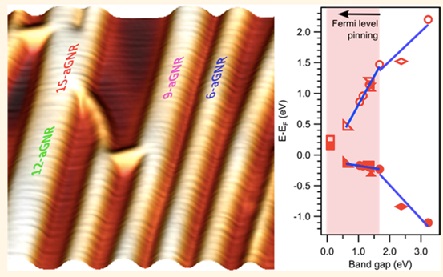
In-situ Study of the Oxygen-Induced Transformation of Pyrochlore Ce2Zr2O7+x to the k-Ce2Zr2O8 phase
Sven Urban, Igor Djerdj, Paolo Dolcet, Limei Chen, Maren Möller, Omeir Khalid, Hava Camuka, Rüdiger Ellinghaus, Chenwei Li, Silvia Gross, Peter J. Klar, Bernd Smarsly, Herbert Over
Chem. Mater., Just Accepted Manuscript
DOI: 10.1021/acs.chemmater.7b03091
I. F.: 9.466
The temporary storage of oxygen in a solid catalyst is imperative for many important industrial oxidation reactions in the gas phase, for instance the post-treatment of automotive exhaust gas. A peculiar mixed Ce-Zr (1:1) oxide, the ordered κ-Ce2Zr2O8 phase, is a promising catalytic material exhibiting an extraordinarily high oxygen storage capacity (OSC) and high thermal and chemical stability. In this paper, we elucidate the temperature-dependent transformation between the pyrochlore pyr-Ce2Zr2O7+x and κ-Ce2Zr2O8 phase upon oxygen uptake by in-situ X-ray diffraction, X-ray absorption and in-situ Raman spectroscopy, providing insights into the electronic and structural changes on the atomic level, which are at the heart of the extraordinarily high OSC. We demonstrate that the Ce3+ concentration can be followed in-situ by Raman spectroscopy of the electronic spin flip in the f-shell of trivalent cerium. The catalytic activity of the κ- e2Zr2O8 phase has been investigated without an additional active component such as Pt: While the high OSC of the kappa phase is beneficial for the oxidation of CO, the oxidation of HCl turns out to be not affected by the high OSC.

Antibiotic-induced dysbiosis of the microbiota impairs gut neuromuscular function in juvenile mice
Valentina Caputi, Ilaria Marsilio, Viviana Filpa, Silvia Cerantola, Genny Orso, Michela Bistoletti, Nicola Paccagnella, Sara De Martin, Monica Montopoli, Stefano Dall’Acqua, Francesca Crema, Iole-Maria Di Gangi, Francesca Galuppini, Isabella Lante, Sara Bogialli, Massimo Rugge, Patrizia Debetto, Cristina Giaroni and Maria Cecilia Giron
British Journal of Pharmacology
DOI: 10.1111/bph.13965
Impact factor: 5.773
First published: 30 August 2017
Background and Purpose. Gut microbiota is essential for the development of the gastrointestinal system, including the enteric nervous system (ENS). Perturbations of gut microbiota in early life have the potential to alter neurodevelopment leading to functional bowel disorders later in life. We examined the hypothesis that gut dysbiosis impairs the structural and functional integrity of the ENS, leading to gut dysmotility in juvenile mice.
Experimental Approach. To induce gut dysbiosis, broad-spectrum antibiotics were administered by gavage to juvenile (3weeks old) male C57Bl/6 mice for 14 days. Bile acid composition in the intestinal lumen was analysed by liquid chromatography-mass spectrometry. Changes in intestinal motility were evaluated by stool frequency, transit of a fluorescent-labelled marker and isometric muscle responses of ileal full-thickness preparations to receptor and non-receptor-mediated stimuli. Alterations in ENS integrity were assessed by immunohistochemistry and Western blot analysis.
Conclusions and Implications. Gut dysbiosis caused complex morpho-functional neuromuscular rearrangements, characterized by structural defects of the ENS and increased tachykininergic neurotransmission. Altogether, our findings support the beneficial role of enteric microbiota for ENS homeostasis instrumental in ensuring proper gut neuromuscular function during critical stages of development.
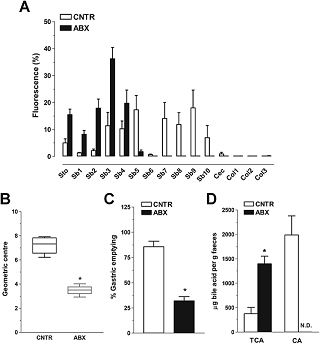
Grand challenges for catalysis in the Science and Technology Roadmap on Catalysis for Europe: Moving ahead catalysis for a sustainable future
Paola Lanzafame, Siglinda Perathoner, Gabriele Centi*, Silvia Gross and Emiel J.M. Hensen
Journal: Catalysis Science & Technology
DOI: 10.1039/C7CY01067B
Impact factor: 5.773
Published on line 19.07.2017
This perspective discusses the general concepts that will guide future catalysis and related grand-challenges, based on "The European Roadmap on Science and Technology of Catalysis" prepared by the European Cluster on Catalysis. To adress the changing scenario in refinery and chemical production, and move to a low-carbon sustrainable future, the distinguishing elements of three grand-challenges for catalysis are discussed here: 1) catalysis to address the evolving energy and chemical scenario, 2) catalysis for a cleaner and sustainable future, and 3) addressing catalysis complexity, the latter being organized in three sub-topics: advanced design of novel catalysts, understanding catalysts from molecular to material scale, and expanding catalysis concepts
Indium selenide: an insight into electronic band structure and surface excitations
A. Politano, D. Campi, M. Cattelan, I. Ben Amara, S. Jaziri, A. Mazzotti, A. Barinov, B. Gürbulak, S. Duman, S. Agnoli, L. S. Caputi, G. Granozzi, and A. Cupolillo
Scientific Reports (IF= 5.228)
DOI : 10.1038/s41598-017-03186-x
We have investigated the electronic response of single crystals of indium selenide by means of angle-resolved photoemission spectroscopy, electron energy loss spectroscopy and density functional theory. The loss spectrum of indium selenide shows the direct free exciton at ~1.3 eV and several other peaks, which do not exhibit dispersion with the momentum. The joint analysis of the experimental band structure and the density of states indicates that spectral features in the loss function are strictly related to single-particle transitions. These excitations cannot be considered as fully coherent plasmons and they are damped even in the optical limit, i.e. for small momenta. The comparison of the calculated symmetry-projected density of states with electron energy loss spectra enables the assignment of the spectral features to transitions between specific electronic states. Furthermore, the effects of ambient gases on the band structure and on the loss function have been probed.
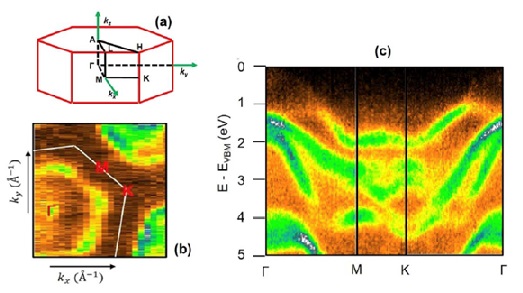
Enhanced Electrocatalytic Oxygen Evolution in Au–Fe Nanoalloys
Vassalini, I., Borgese, L., Mariz, M., Polizzi, S., Aquilanti, G., Ghigna, P., Sartorel, A., Amendola, V. and Alessandri, I.
Chem. Int. Ed., 2017
doi: 10.1002/anie.201703387
Au–Fe nanoparticles synthesized by laser ablation in solution exhibit enhanced activity in the oxygen evolution reaction (see diagram). The results open exciting perspectives for using nanoalloys in catalysis and energy conversion.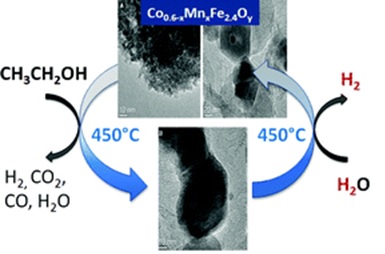
Sustainable and surfactant-free high-throughput synthesis of highly dispersible zirconia nanocrystals
C. Suchomski, D. J. Weber, P. Dolcet, A. Hofmann, P. Vöpel, J. Yue, M. Einert, M. Möller, S. Werner, S. Gross, I. Djerdj, T. Brezesinski and B. M. Smarsly
Journal of Material Chemistry A
DOI: 10.1039/c7ta02316b
I. F.: 8.262
First published online 24 April 2017
A cost-effective and tailored synthesis route for the preparation of cubic ZrO2 nanocrystals with high dispersibility was developed. The procedure is straightforward and produces uniform 2–3 nm particles of excellent yield when applying microwave dielectric heating as a “green” method. Furthermore, it can be applied to a wide range of batch sizes (from 0.5 to 20 g ZrO2), which makes it interesting for industrial applications, and also lends itself to the preparation of yttria-stabilized ZrO2 nanocrystals with varying doping levels. The work provides a blueprint for the fabrication of high-quality nanoparticles and structured materials thereof and is likely to trigger further research in the field of solution-processed metal oxides.
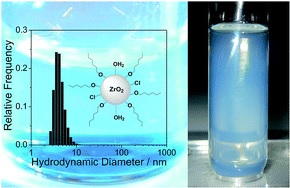
Electrocrystallization of Monolayer-Protected Gold Clusters: Opening the Door to Quality, Quantity, and New Structures
Sabrina Antonello, Tiziano Dainese, Fangfang Pan, Kari Rissanen, and Flavio Maran
Thiolate-protected metal clusters are materials of ever-growing importance in fundamental and applied research. Knowledge of their single-crystal X-ray structures has been instrumental to enable advanced molecular understanding of their intriguing properties. So far, however, a general, reliable, chemically clean approach to prepare single crystals suitable for accurate crystallographic analysis was missing. Here we show that single crystals of thiolate-protected clusters can be grown in large quantity and very high quality by electrocrystallization.
J. Am. Chem. Soc., Article ASAP
Open Access
Publication Date (Web): March 10, 2017
AlphaGalileo University of Jyväskylä (Finland)
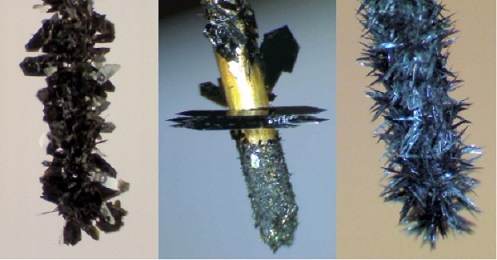
Pursuing the stabilisation of crystalline nanostructured magnetic manganites through a green low temperature hydrothermal synthesis
Arianna Minelli, Paolo Dolcet, Stefano Diodati, Sandra Gardonio, Claudia Innocenti, Denis Badocco, Stefano Gialanella, Paolo Pastore, Luciano Pandolfo, Andrea Caneschi, Angela Trapananti Silvia Gross
Journal of Material Chemistry C
DOI: 10.1039/c6tc05636a
I. F.: 5.066
First published online 23 Feb 2017
A quick, easy and green water-based synthesis protocol involving coprecipitation of oxalates combined with hydrothermal treatment was demonstrated to be very effective in yielding and stabilising, at relatively low temperature (180°C) and in water, the crystallisation of nanostructured manganites. The subcritical hydrothermal approach was in fact shown to play a key role in stabilising phases which are generally achieved at much higher temperatures, and in harsher conditions, thus disclosing an exciting alternative for their synthesis. As a result of this mild wet chemistry approach, the compounds CuMnO2, ZnMn2O4 and ZnMnO3 were synthesised as nanocrystalline powders. Noticeably, the optimised route proved to be effective in stabilising the exotic polymorph cubic spinel ZnMnO3 as a pure compound. This is particularly notable, as very few records concerning this compound are available in literature. The manganites were characterised from a structural (XRPD and SAED, morphological (TEM and SEM) and compositional (XPS, ICP-MS, XAS and CHN analysis) point of view. Since these materials are particularly interesting for functional properties ascribed to their magnetic behaviour, SQUID was employed to study their magnetic properties, yielding a response that could indicate either ferrimagnetic or antiferromagnetic behaviour in CuMnO2 and ZnMnO3.
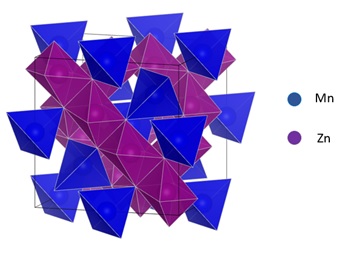
Polylysine-Grafted Au144 Nanoclusters: Birth and Growth of a Healthy Surface-Plasmon-Resonance-like Band
Ivan Guryanov, Federico Polo, Evgeniy Ubyvovk, Evgenia Vlakh, Tatiana Tennikova, Armin Tahmasbi Rad, Mu-Ping Nieh and FLAVIO MARAN
Chem. Sci., 2017, Accepted Manuscript
DOI: 10.1039/C6SC05187A
First published online 02 Feb 2017
Poly(amino acid)-coated gold nanoparticles hold promises in biomedical applications, particularly because they combine unique physicochemical properties of the gold core, excellent biocompatibility, and easy functionalization of the poly(amino acid)-capping shell. Here we report a novel method of the preparation of robust hybrid core-shell nanosystems consisting of a Au144 cluster and a densely grafted polylysine layer. Linear polylysine chains were grown by direct N-carboxyanhydride (NCA) polymerization onto ligands capping the gold nanocluster. The density of the polylysine chains and the thickness of the polymer layer strongly depend on the amount and concentration of the NCA monomer and the initiator. The optical spectra of the so-obtained core-shell nanosystems show a strong surface plasmon resonance (SPR) like band at 531 nm. In fact, despite the gold-cluster size is maintained and the absence of interparticle aggregation, the polylysine-capped clusters behave as if they had a diameter nearly 4 times larger. To the best of our knowledge, this is the first observation of the growth of a fully developed, very stable SPR-like band for a gold nanocluster of such dimension. The robust polylysine protective shell makes the nanoparticles very stable under conditions of chemical etching, in the presence of glutathione, and at different pH values, without gold core deshielding or alteration of the SPR-like band. This polymerization method can be conceivably extended to prepare core-shell nanosystems based on other mono- or co-poly(amino acids).
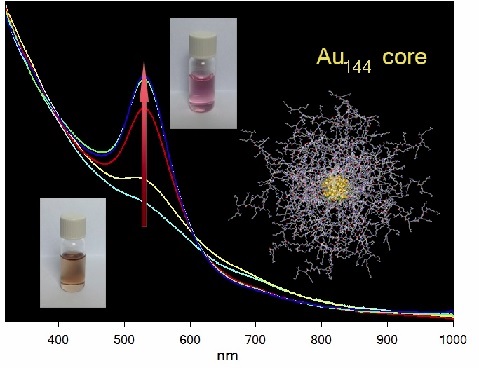
Photoswitchable Catalysis by a Nanozyme Mediated by a Light-Sensitive Cofactor
Simona Neri, Sergio Garcia Martin, Cristian Pezzato and Leonard J. Prins
DOI: 10.1021/jacs.6b12932
Published: January 2017
The activity of a gold nanoparticle-based catalyst can be reversibly up- and down-regulated by light. Light is used to switch a small molecule between cis- and trans-isomers, which inhibits the catalytic activity of the nanoparticles to different extent. The system is functional in aqueous buffer, which paves the way for integrating the system in biological networks.
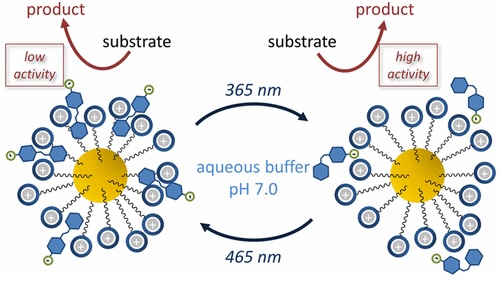
From Blue to Green: Fine-Tuning of Photoluminescence and Electrochemiluminescence in Bifunctional Organic Dyes
Fabio Rizzo, Federico Polo, Gregorio Bottaro, Simona Fantacci, Sabrina Antonello, Lidia Armelao, Silvio Quici, and Flavio Maran
DOI: 10.1021/jacs.6b12247
Published: January 15, 2017
We describe the synthesis, computational analysis, photophysics, electrochemistry and electrochemiluminescence (ECL) of a series of compounds formed of two triphenylamines linked by a fluorene or spirobifluorene bridge. The
phenylamine moieties were modified at the para-position of the two external rings by electron-withdrawing or electron-donating substituents. These modifications allowed for fine-tuning of the photoluminescence (PL) and ECL emission from blue to green,
with an overall wavelength span of 73 (PL) and 67 (ECL) nm, respectively. For all compounds, we observed a very high PL quantum yield (79−89%) and formation of stable radical ions. The ECL properties were investigated by direct annihilation of the
electrogenerated radical anion and radical cation. The radical-ion annihilation process is very efficient and causes an intense greenish-blue ECL emission, easily observable even by naked eye, with quantum yield higher than the standard 9,10-
diphenylanthracene. The ECL spectra show one single band that almost matches the PL band. Because the energy of the annihilation reaction is higher than that required to form the singlet excited state, the S-route is considered the favored pathway followed by the ECL process in these
molecules. All these features point to this type of molecular system as promising for ECL applications.
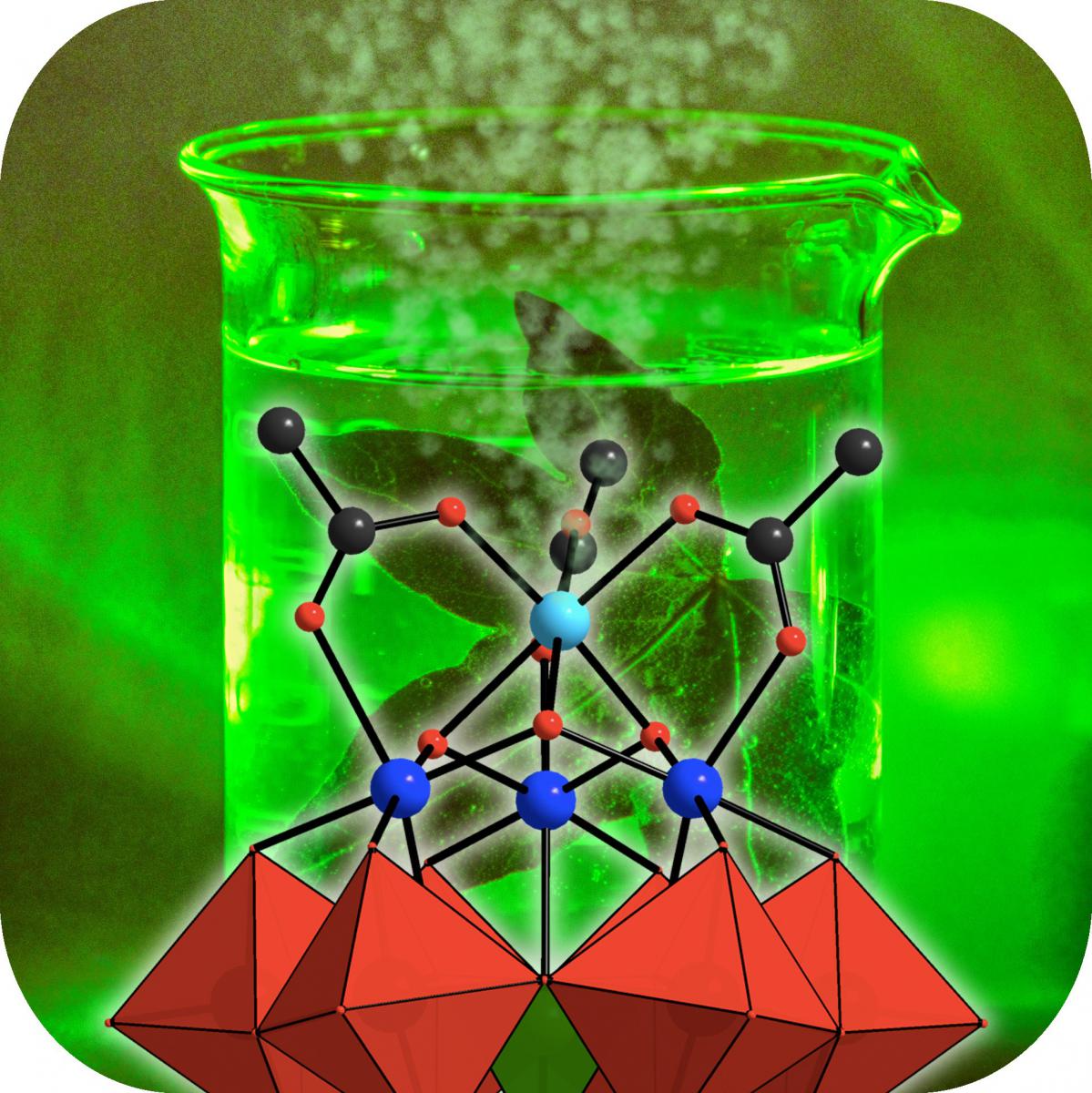
Synergy of Miniemulsion and Solvothermal Conditions for the Low Temperature Crystallization of Magnetic Nanostructured Transition Metal Ferrites
Alice Antonello, Gerhard Jakob, Paolo Dolcet, Rebecca Momper, Maria Kokkinopoulou, Katharina Landfester, Rafael Muñoz-Espí, Silvia Gross*
Journal: Chemistry of Materials
IF: 9.407
DOI: 10.1021/acs.chemmater.6b03467
Accepted December 30 2016
Crystalline first row transition metal (Mn, Fe, Co, Ni, Cu and Zn) ferrites were prepared by an unprecedented synergetic combination of miniemulsion synthesis and solvothermal route, pursuing unconventional conditions in terms of space confinement, temperature and pressure. This synergy allowed for obtaining different crystalline ferrites at much lower temperature (i.e., 80 °C) than usually required and without any post-synthesis thermal treatment. X-ray diffraction (XRD) revealed that analogous ferrites synthesized by miniemulsion at ambient pressure or in bulk either at ambient pressure or under solvothermal conditions did not result in comparatively highly crystalline products. To follow the structural evolution at local level as a function of reaction time and depending on the synthesis conditions, X-ray absorption spectroscopy (XAS) was used to determine the cation distribution in these structures. Well-defined nanostructures were observed by transmission electron microscopy (TEM). Concerning their functional behavior, the synthesized ferrites presented superparamagnetism and were found to be active oxidation catalysts, as demonstrated for the oxidation of styrene, taken as a model reaction. Thanks to the magnetic properties, the ferrites can be easily recovered from the reaction medium, after the catalysis, by magnetic separation and reused for several cycles without losing activity.
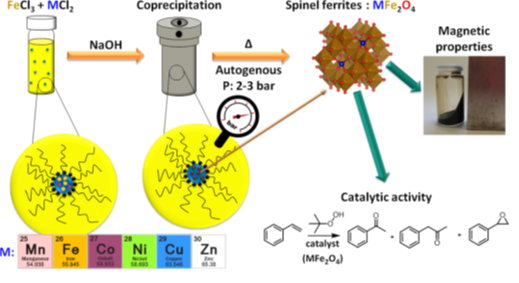
Light-Induced Porphyrin-Based Spectroscopic Ruler for Nanometer Distance Measurements
Marilena Di Valentin*, Marco Albertini, Maria Giulia Dal Farra, Enrico Zurlo, Laura Orian, Antonino Polimeno, Marina Gobbo and Donatella Carbonera
Journal: Chemistry-A European Journal IF: 5.771
DOI: 10.1002/chem.201603666
First published:9 November 2016
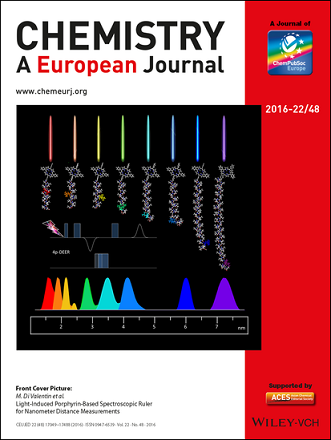
Dual Role of Zirconium Oxoclusters in Hybrid Nanoparticles: Cross-Linkers and Catalytic Sites
Cesare Benedetti, Alessandro Cazzolaro, Mauro Carraro, Robert Graf, Katharina Landfester, Silvia Gross*, and Rafael Muñoz-Espí*
Journal: ACS Applied Materials & Interfaces IF: 7.145
DOI: 10.1021/acsami.6b07023
Accepted 9 September 2016
Organic–inorganic hybrid nanoparticles are prepared by free-radical copolymerization of methyl methacrylate (MMA) with the structurally well-defined methacrylate-functionalized zirconium oxocluster Zr4O2(methacrylate)12. The polymerization process occurs in the confined space of miniemulsion droplets. The formation of covalent chemical bonds between the organic and the inorganic counterparts improves the distribution of the guest species (oxoclusters) in the polymer particles, overcoming problems related to migration, leaching and stability. Because of the presence of a high number of double bonds (12 per oxocluster), the oxoclusters act as efficient cross-linking units for the resulting polymer matrix, thus ruling its swelling behavior in organic solvents. The synthesized hybrid nanostructures are applied as heterogeneous systems in the catalytic oxidation of an organic sulfide to the corresponding sulfoxide and sulfone by hydrogen peroxide, displaying quantitative sulfide conversion in 4-24 h with more than 2000 catalytic cycles.
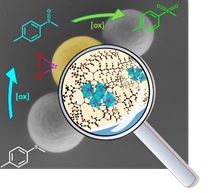
Unveiling the Mechanisms Leading to H2 Production Promoted by Water Decomposition on Epitaxial graphene at Room Temperature
A. Politano, M. Cattelan, D.W. Boukhvalov, D. Campi, A. Cupolillo, S. Agnoli, N.G. Apostol, P. Lacovig, S. Lizzit, D. Farías, G. Chiarello, G. Granozzi, and R. Larciprete
ACS Nano (IF: 12.881)
DOI: 10.1021/acsnano.6b00554
By means of a combination of surface-science spectroscopies and theory, we have investigated the mechanisms ruling the catalytic role of epitaxial graphene (Gr) grown on transition-metal substrates for the production of hydrogen from water. Water decomposition at the Gr/metal interface at room temperature provides a hydrogenated Gr sheet, which is buckled and decoupled from the metal substrate. We evaluated the performance of Gr/metal interface as a hydrogen storage medium, with a storage density in the Gr sheet comparable with state-of-the-art materials (1.42 wt.%). Moreover, thermal programmed reaction experiments showed that molecular hydrogen can be released upon heating the water-exposed Gr/metal interface above 400 K. The Gr hydro/dehydrogenation process might be exploited for an effective and eco-friendly device to produce (and store) hydrogen from water, i.e. starting from an almost unlimited source.
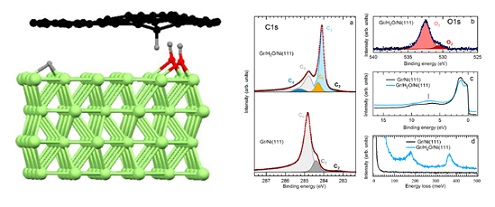
Synthesis and full characterization of the phase-pure pyrochlore Ce2Zr2O7 and the k-Ce2Zr2O8 phases
Sven Urban, Paolo Dolcet, Maren Möller, Limei Chen, Peter J. Klar, Igor Djerdj, Silvia Gross, Bernd Smarsly, Herbert Over
Applied Catalysis B: Environmental
I. F.: 7.435
It is known that the k-Ce2Zr2O8 phase is an active oxidation catalyst with an extraordinarily high oxygen storage capacity. The k-Ce2Zr2O8 phase is synthesized starting from t-Ce0.5Zr0.5O2 solid solution which is reduced by hydrogen at high temperatures to form the pyrochlore Ce2Zr2O7 phase (pyr-Ce2Zr2O7) with high degree of ordering of the cationic sublattice. The final step in the synthesis of the k-Ce2Zr2O8 phase includes a mild re-oxidation of pyr-Ce2Zr2O7 at around 600 °C under atmospheric conditions. Yet, the optimum synthesis of the k-Ce2Zr2O8 phase is still not settled since most of the previous studies used reduction temperatures of 1300 °C and below. We show in contribution that 1300 °C is not sufficient to warrant the preparation of phase-pure pyr-Ce2Zr2O7 and k-Ce2Zr2O8, but rather that temperatures as high as 1500 °C are required to assure phase purity. This conclusion is drawn from extended X-ray diffraction and X-ray absorption spectroscopy analysis together with Raman spectroscopy, providing in-depth details of the structure on the level of both, the evolution of the special periodic structure and the coordination of the metal atoms.







